Comba Telecom RA-5700-D Master Unit of Tri-band Distributed Antenna System User Manual REV2
Comba Telecom Ltd. Master Unit of Tri-band Distributed Antenna System REV2
User manual REV2

USER MANUAL FOR RA-5700
RA-5700 QI
Copyright - refer to title page
Page 1
ENU Status : 1-1-2
USER MANUAL
The information contained herein is the
responsibility of and is approved by the
following, to whom all enquiries should
be directed in the first instance:
Comba Telecom Ltd.
This is an unpublished work the copyright in which vests in Comba International ("Comba"). All rights reserved.
The information contained herein is confidential and the property of Comba and is supplied without liability for errors or
omissions. No part may be reproduced, disclosed or used except as authorised by contract or other written permission. The
copyright and the foregoing restriction on reproduction and use extend to all media in which the information may be embodied.
RA-5700
TRI-BAND DISTRIBUTED ANTENNA
SYSTEM
USER MANUAL FOR RA-5700
RA-5700 QI
Copyright - refer to title page
Page 2
ENU Status : 1-1-2
0.2 CONTENTS
Section
Page
0.2 CONTENTS ........................................................................................................................... 2
0.3 INDEX TO FIGURES AND TABLES ..................................................................................... 4
0.4 HISTORY ............................................................................................................................... 6
0.5 GLOSSARY OF TERMS ....................................................................................................... 7
0.6 FCC SAFETY COMPLIANCE ................................................................................................ 8
0.7 SAFETY NOTICES AND ADMONISHMENTS .................................................................... 10
1 GENERAL INFORMATION ................................................................................................. 11
2 EQUIPMENT DESCRIPTION .............................................................................................. 13
2.1 SYSTEM DIAGRAM ............................................................................................................ 13
2.2 TYPICAL APPLICATION ..................................................................................................... 14
2.2.1 SINGLE FIBER CONFIGURATION ..................................................................................... 14
2.3 EQUIPMENT LAYOUT ........................................................................................................ 15
2.4 EQUIPMENT CONSTITUTION ........................................................................................... 17
2.5 KIT OF PARTS .................................................................................................................... 18
3 INSTALLATION ................................................................................................................... 19
3.1 WARNINGS AND ALERTS ................................................................................................. 19
3.2 SITE PLANNING CONSIDERATIONS ................................................................................ 20
3.2.1 SYSTEM INSTALLATION CHECKLIST .............................................................................. 21
3.3 INSTALLATION PROCEDURES ......................................................................................... 22
3.3.1 GOODS INWARDS INSPECTION ...................................................................................... 22
3.3.2 TOOLS ................................................................................................................................. 22
3.3.3 PREPARATION ................................................................................................................... 22
3.3.4 CABINET MOUNTING OF MU ............................................................................................ 23
3.3.5 RU MOUNTING RACK DIMENSION .................................................................................. 23
3.3.6 WALL MOUNTING OF RU .................................................................................................. 24
3.3.7 POLE MOUNTING OF RU .................................................................................................. 25
3.3.8 DRIP-LOOP ......................................................................................................................... 25
3.4 EQUIPMENT CONNECTORS ............................................................................................. 26
3.4.1 MU CONNECTORS............................................................................................................. 26
3.4.2 RU CONNECTORS ............................................................................................................. 27
3.5 EQUIPMENT CONNECTION .............................................................................................. 28
3.5.1 GROUNDING CONNECTION ............................................................................................. 28
3.5.2 LI-ION BATTERY CONNECTION ....................................................................................... 28
3.5.3 OPTICAL CONNECTION .................................................................................................... 28
3.5.4 EXTERNAL ALARM CONNECTION ................................................................................... 30
3.5.5 BTS ALARM CONNECTION ............................................................................................... 31
3.5.6 CONNECT TO PC ............................................................................................................... 32
4 COMMISSIONING ............................................................................................................... 33
4.1 PRE-COMMISSIONING TASKS ......................................................................................... 33
4.2 MU/RU RESET TIME DURATION ...................................................................................... 33
4.3 LED INDICATORS ............................................................................................................... 34
4.3.1 MU LED INDICATORS ........................................................................................................ 34
4.3.2 RU LED INDICATORS ........................................................................................................ 34
4.4 WEB OMT ........................................................................................................................... 35
4.4.1 CONNECTION FROM PC TO EQUIPMENT ...................................................................... 35
USER MANUAL FOR RA-5700
RA-5700 QI
Copyright - refer to title page
Page 3
ENU Status : 1-1-2
4.4.2 OMT CONFIGURATION ..................................................................................................... 36
4.4.3 SYSTEM INFORAMTION .................................................................................................... 36
4.4.4 RF INFORMATION .............................................................................................................. 39
4.4.5 ALARM INFORMATION ...................................................................................................... 42
4.4.6 PROPERTIES INFORMATION ........................................................................................... 44
4.4.7 USER MANAGEMENT ........................................................................................................ 46
4.4.8 HELP ................................................................................................................................... 47
4.4.9 CHANGE PASSWORD ....................................................................................................... 48
5 TROUBLESHOOTING ........................................................................................................ 49
6 MAINTENANCE ................................................................................................................... 50
7 APPENDICES ...................................................................................................................... 51
7.1 APPENDIX A: BAND SELECTIVE UNIT USER MANUAL .................................................. 51
7.1.1 BS-8132 BSU (BAND SELECTIVE UNIT) ........................................................................... 51
7.1.2 BS-1933 BSU ...................................................................................................................... 52
7.1.3 BS-8132&BS-1933 BSU LAYOUT ....................................................................................... 53
7.1.4 BS-8132&BS-1933 KOP ...................................................................................................... 53
7.1.5 BSU OMT ........................................................................................................................... 54
7.1.6 BS-1933 OMT ..................................................................................................................... 56
7.1.7 BS-8132 OMT ...................................................................................................................... 59
7.1.8 BS-8132&BS-1933 BSU CONNECTORS ........................................................................... 62
7.2 APPENDIX B: TOOLS FOR INSTALLATION AND MAINTENANCE .................................. 63
7.3 APPENDIX C: OVERDRIVE PROTECTION PROCEDURE ............................................... 64
7.4 APPENDIX D: SERVICING POLICY AND RETURN OF EQUIPMENT .............................. 65
7.5 APPENDIX E: RMA (RETURN MATERIAL AUTHORIZATION) FORM ............................. 66
USER MANUAL FOR RA-5700
RA-5700 QI
Copyright - refer to title page
Page 4
ENU Status : 1-1-2
0.3 INDEX TO FIGURES AND TABLES
Figure 1: View of MU Fully Equipped Shelf ........................................................................................................... 11
Figure 2: Front, Side and Bottom Views of RU Enclosure .................................................................................. 12
Figure 3: System Diagram ....................................................................................................................................... 13
Figure 4: Application of One MU with One RU through One Optical Module with WDM ................................ 14
Figure 5: Application of One MU with Four RUs through four Optical Modules with WDM ............................ 15
Figure 6: MU Equipment Layout ............................................................................................................................. 15
Figure 8: Cabinet Mounting of 19” Shelf ................................................................................................................ 23
Figure 9: RU Mounting Rack Dimension ............................................................................................................... 24
Figure 10: RU Wall Mounting .................................................................................................................................. 24
Figure 11: Pole Mounting of RU .............................................................................................................................. 25
Figure 12: MU Front Panel Connectors ................................................................................................................. 26
Figure 13: MU Back Panel Connectors.................................................................................................................. 26
Figure 14: RU Connectors ....................................................................................................................................... 27
Figure 15: Optical Connection ................................................................................................................................. 29
Figure 16: Pins Allocation for “EXT_ALM” Port for MU ....................................................................................... 30
Figure 17: Pins Allocation for “EXT_ALM” Port for RU ........................................................................................ 30
Figure 18: Pins Allocation for “BTS_ALM” Port .................................................................................................... 31
Figure 19: Web OMT Access .................................................................................................................................. 35
Figure 20: Log in ....................................................................................................................................................... 36
Figure 21: System Information ................................................................................................................................ 37
Figure 22: Firmware Update .................................................................................................................................... 37
Figure 23: Maintenance............................................................................................................................................ 38
Figure 24: Data Import ............................................................................................................................................. 38
Figure 25: Data Export ............................................................................................................................................. 39
Figure 26: Switch....................................................................................................................................................... 39
Figure 27: Alarm Threshold ..................................................................................................................................... 40
Figure 28: Temperature ........................................................................................................................................... 40
Figure 29: ATT........................................................................................................................................................... 41
Figure 30: Power ....................................................................................................................................................... 41
Figure 31: Gain .......................................................................................................................................................... 42
Figure 33: Master Alarm........................................................................................................................................... 43
Figure 34: Channel Alarm ........................................................................................................................................ 43
Figure 35: External Alarm ........................................................................................................................................ 43
Figure 36: Equipment ID .......................................................................................................................................... 44
Figure 37: Equipment Info. ...................................................................................................................................... 44
Figure 38: Site Location ........................................................................................................................................... 45
Figure 39: System Clock .......................................................................................................................................... 45
Figure 40: Comm. Config. ........................................................................................................................................ 45
Figure 41: Firmware Information ............................................................................................................................. 46
Figure 42: User Information ..................................................................................................................................... 46
Figure 43: Set Session Time ................................................................................................................................... 47
Figure 44: Help .......................................................................................................................................................... 47
Figure 45: About ........................................................................................................................................................ 47
Figure 46: Password Configuration ........................................................................................................................ 48
Figure 47: Change Password .................................................................................................................................. 48
Figure 48: BSU Layout ............................................................................................................................................. 53
Figure 49: Connection Type .................................................................................................................................... 54
Figure 50: Serial Port Configuration ....................................................................................................................... 55
Figure 52: System Information ................................................................................................................................ 56
Figure 53: Auto-Read ............................................................................................................................................... 56
Figure 54: Switch....................................................................................................................................................... 57
Figure 55: Channel NO. ........................................................................................................................................... 57
Figure 56: Channel Alarm ........................................................................................................................................ 58
USER MANUAL FOR RA-5700
RA-5700 QI
Copyright - refer to title page
Page 5
ENU Status : 1-1-2
Figure 57: Equipment ID .......................................................................................................................................... 58
Figure 58: System Information ................................................................................................................................ 59
Figure 59: Auto-Read ............................................................................................................................................... 60
Figure 60: Switch....................................................................................................................................................... 60
Figure 61: Channel NO. ........................................................................................................................................... 61
Figure 62:Channel Alarm ......................................................................................................................................... 61
Figure 63: Equipment ID .......................................................................................................................................... 61
Figure 64: BSU Connectors ..................................................................................................................................... 62
Figure 65: BSU Connection Overview ................................................................................................................... 63
Table 1: MU Constitution.......................................................................................................................................... 17
Table 2: RU Constitution .......................................................................................................................................... 17
Table 3: MU KOP ...................................................................................................................................................... 18
Table 4: RU KOP ...................................................................................................................................................... 18
Table 5: MU Front Panel Connections ................................................................................................................... 26
Table 6: MU Back Panel Connections ................................................................................................................... 26
Table 7: RU Connections ......................................................................................................................................... 27
Table 8: Pin Definition of “EXT_ALM” Port for MU ............................................................................................... 30
Table 9: Pin Definition of “EXT_ALM” Port for RU ............................................................................................... 30
Table 10: MU LED Indicators .................................................................................................................................. 34
Table 11: RU LED Indicators ................................................................................................................................... 34
Table 12: IP Setting Quick Look-up Table ............................................................................................................. 36
Table 13: Equipment ID ........................................................................................................................................... 44
Table 14: Alarms Diagnosis ..................................................................................................................................... 50
Table 15: Bandwidth and Channel No. .................................................................................................................. 51
Table 16: BS-1933 KOP ........................................................................................................................................... 53
Table 17: BS-8132 KOP ........................................................................................................................................... 54
USER MANUAL FOR RA-5700
RA-5700 QI
Copyright - refer to title page
Page 6
ENU Status : 1-1-2
0.4HISTORY
Change No.
ENU
Details Of Change
1
1-0-0
This user manual first created on 28May2010 which referred to its
Chinese manual RA-5700-1001YH released in May 2010.
2
1-1-0
Updated Web OMT, added BUS layout in this document in Oct
2010.
3
1-1-1
Update the user manual based on the requirement in Dec 2010.

USER MANUAL FOR RA-5700
RA-5700 QI
Copyright - refer to title page
Page 7
ENU Status : 1-1-2
0.5 GLOSSARY OF TERMS
ALC
Automatic Level Control
ATT
Attenuation
BS
Base Station
BTS
Base Transceiver Station
dB
Decibel
dBm
Decibels relative to 1 milliwatt
DL
Downlink
DPX
Duplexer
DT
Donor Terminal
EEPROM
Electrically Erasable Programmable Read Only Memory
E/O,O/E
Electrical/Optical, Optical/Electrical
Hz
Hertz
ID
Identification
LNA
Low Noise Amplifier
MCU
Main Control Unit
MHz
Megahertz
MT
Mobile Terminal
MTBF
Mean Time Between Failures
NC
Normally Closed
NF
Noise Figure
NO
Normally Open
OMC
Operation & Maintenance Center
OMT
Operation & Maintenance Terminal
OP
Optical Fiber
PA
Power Amplifier
PLL
Phase Locked Loop
POI
Point of Interconnects
PSU
Power Supply Unit
RF
Radio Frequency
RX
Receive
SMA
Sub-Miniature “A” Connector
TX/RX
Transmit/Receive
UL
Uplink
VAC
Volts Alternating Current
VSWR
Voltage Standing Wave Ratio
WCDMA
Wideband Code Division Multiple Access
WDM
Wavelength Division Multiplexer

USER MANUAL FOR RA-5700
RA-5700 QI
Copyright - refer to title page
Page 8
ENU Status : 1-1-2
0.6 FCC SAFETY COMPLIANCE
Comaba Tri-band Distributed Antenna System (DAS) has been tested and complies with the FCC rules.
FCC ID: PX8RA-5700-R
Environmental evaluation and exposure limit according to FCC CFR 47part 1, §1.1307, §1.1310
The below table shows the RF exposure for fixed repeater
Antenna Type
Safe
Distance
(cm)
Antenna
EIRP(mW)
Antenna
Input
Power(dBm)
Antenna
Gain(dBi)
Requirement
(mW/cm2)
Frequency(
MHz)
1
IXD-
120V06K0-
2(1710-
2500MHz)
17.80
3981.07
30
6
1.00
1960
2
IXD-
120V06N0-
3(806-
960/1710-
2500MHz)
23.22
3981.07
30
6
0.59
881
17.80
3981.07
30
6
1.00
1960
3
IXD-
360V03K0-
2(1710-
2500MHz)
11.36
1621.81
30
2.1
1.00
1960
4
IXD-
360V03N0-
2(806-
960/1710-
2500MHz)
18.45
2511.89
30
4
0.59
881
14.14
2511.89
30
4
1.00
1960
5
IXD-
360V03N0-
3(806-
960/1710-
2500MHz)
20.00
2951.21
30
4.7
0.59
881
15.32
2951.21
30
4.7
1.00
1960
6
IXD-
360V03N0-
33(698-
896/1710-
2700MHz)
25.39
3981.07
30
6
0.49
737
25.15
3981.07
30
6
0.50
751
23.22
3981.07
30
6
0.59
881
17.80
3981.07
30
6
1.00
1960
7
IXD-
360V03N0-
52(806-
960/1710-
2700MHz)
20.00
2951.21
30
4.7
0.59
881
15.32
2951.21
30
4.7
1.00
1960
8
IXD-
360V03N0-
54(698-
960/1710-
2700MHz)
20.17
2511.89
30
4
0.49
737
19.98
2511.89
30
4
0.50
751
18.45
2511.89
30
4
0.59
881
14.14
2511.89
30
4
1.00
1960

USER MANUAL FOR RA-5700
RA-5700 QI
Copyright - refer to title page
Page 9
ENU Status : 1-1-2
Antenna
Type
Safe
Distance
(cm)
Antenna
EIRP(mW)
Antenna
Input
Power(dBm)
Antenna
Gain(dBi)
Requirement
(mW/cm2)
Frequency(
MHz)
9
IXD-
360V03N0-
6(806-
960/1710-
2500MHz)
20.00
2951.21
30
4.7
0.59
881
15.32
2951.21
30
4.7
1.00
1900
10
IWH-
090V08N0-
2(806-
960/1710-
2700MHz)
29.45
6309.57
30
8
0.58
869
22.41
6309.57
30
8
1.00
1900
11
IWH-
120V06N0-
1(806-
960/1710-
2500MHz)
23.22
3981.07
30
6
0.59
881
17.80
3981.07
30
6
1.00
1900
*Antenna type: comtact Comba US office if any questions regarding out antenna product and service.
FCC ID: PX8RA-5700-D
PX8RA-5700-D is connected to BTS output via RF cable and coupler, the RF output power is less than 1
mW and far below the BTS output power, so the safety expossure distance is short than BTS safety
exposure distance, no additional notice for safety exposure distance.
USER MANUAL FOR RA-5700
RA-5700 QI
Copyright - refer to title page
Page 10
ENU Status : 1-1-2
0.7 SAFETY NOTICES AND ADMONISHMENTS
This document contains safety notices in accordance with appropriate standards. In the interests of
conformity with the territory standards for the country concerned, the equivalent territorial admonishments
are also shown.
Any installation, adjustment, maintenance and repair of the equipment must only be carried out by trained,
authorized personnel. At all times, personnel must comply with any safety notices and instructions.
Specific hazards are indicated by symbol labels on or near the affected parts of the equipment. The labels
conform to international standards, are triangular in shape, and are coloured black on a yellow
background. An informative text label may accompany the symbol label.
Hazard labeling is supplemented by safety notices in the appropriate equipment manual. These notices
contain additional information on the nature of the hazard and may also specify precautions.
Warning:
These draw the attention of personnel to hazards that may cause death or injury to the operator or others.
Examples of use are cases of high voltage, laser emission, toxic substances, point of high temperature,
etc.
Alert:
These draw the attention of personnel to hazards that may cause damage to the equipment. An example
of use is the case of static electricity hazard.
Caution notices may also be used in the handbook to draw attention to matters that do not constitute a risk
of causing damage to the equipment but where there is a possibility of seriously impairing its performance,
e.g. by mishandling or gross maladjustment. Warnings and Cautions within the main text do not
incorporate labels and may be in shortened form.
End of Section
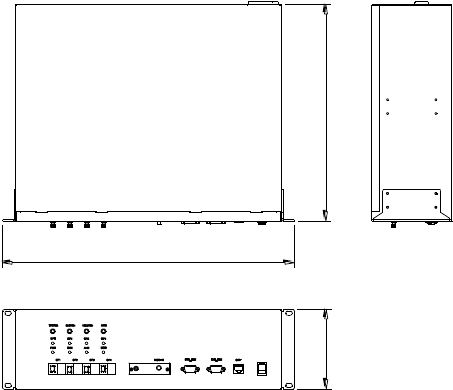
USER MANUAL FOR RA-5700
RA-5700 QI
Copyright - refer to title page
Page 11
ENU Status : 1-1-2
1 GENERAL INFORMATION
The RA-5700 Tri-Band Distributed Antenna System (hereinafter called “RA-5700”) is designed for working
on 700MHz, 850MHz and 1900MHz networks. It provides flexible and scalable solution of multi-band,
multi-operator coverage extension applications.It is the ideal solution to both indoor and outdoor as well.
RA-5700 consists of Master Unit (MU) RA-5700-D and Remote Unit (RU) RA-5700-R.
The low signal transmission loss of optical fiber is applicable for long distance transmission. RA-5700 can
support the optical transmission of up to 5dB signal transmission loss. It can extend BTS coverage and
eliminate blindspot, shadow area and weak-signal area to improve call quality.
Main feature:
High output power with high linearity, which supports multiple carrier operation and ensures the signal
source is of good quality.
Optical fiber transmission with long distance transition at the most path loss of 5dB.
Local Operation and Maintenance Terminal (OMT): operating status and parameters can be set or
monitored by OMT PC locally. And the point-to-point setting and inquiry between MU and RU is
realizable through the integrated wireline/wireless modem, which makes it convenient for on-site
configuration.
Operation Maintenance Center (OMC): system working parameters and communication configuration
can be set or inquired remotely through the integrated Ethernet adaptor. If alarm is generated, the
equipment will dial up to OMC automatically in the mode of GPRS.
Build-in Li-ion battery ensures that alarm information can automatically report to OMC in case of
equipment power failure.
RU is designed for all-weather outdoor operation - waterproof, damp-proof and omni-sealed.
The figures below show the equipment enclosure layout of RA-5700 MU and RU:
5.2" 17.2"
19"
Figure 1: View of MU Fully Equipped Shelf
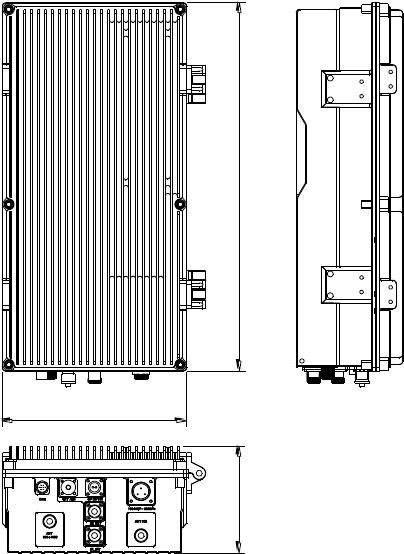
USER MANUAL FOR RA-5700
RA-5700 QI
Copyright - refer to title page
Page 12
ENU Status : 1-1-2
20"
5"
10"
Figure 2: Front, Side and Bottom Views of RU Enclosure
End of Section
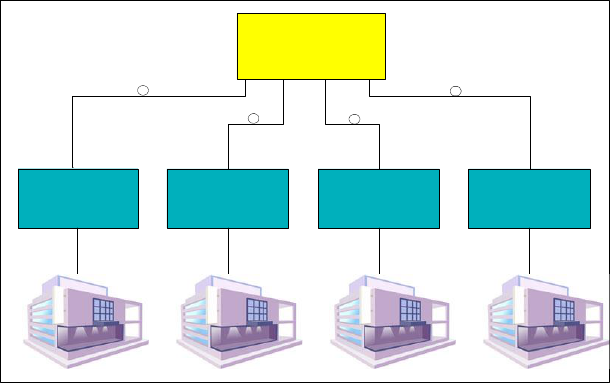
USER MANUAL FOR RA-5700
RA-5700 QI
Copyright - refer to title page
Page 13
ENU Status : 1-1-2
2 EQUIPMENT DESCRIPTION
2.1 SYSTEM DIAGRAM
RU
Optical Fiber
MU
RU RU RU
Optical Fiber
Cable
Distribution
Cable
Distribution
Cable
Distribution
Cable
Distribution
Figure 3: System Diagram
On the DL, combined signals as 700MHz, 850MHz and 1900MHz from the BTSs converted into optical
signals after amplification in the MU.Then the optical signals are transmitted to the RU via optical fiber.
The Optical TX/RX Module of RU converts the DL optical signals into RF signals. After amplification, the
signals are transmitted at the MT port to the service antenna.
On the UL, the signals transmitted by the mobile are converted into optical signals, and then via the UL
optical fiber. The signals are transmitted to MU, which then converts the optical signals back to RF
signals.
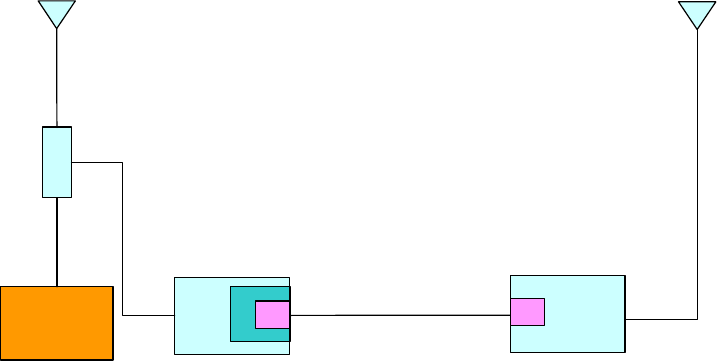
USER MANUAL FOR RA-5700
RA-5700 QI
Copyright - refer to title page
Page 14
ENU Status : 1-1-2
2.2 TYPICAL APPLICATION
2.2.1 SINGLE FIBER CONFIGURATION
For equipments with WDM Unit, the single fiber configuration is applicable. Through using WDM
technique, one fiber is shared between optical signals.
Refer to the following two applications of single fiber configuration:
2.2.1.1 Typical Application of Single Fiber Configuration
Shown below is a typical application showing the ability to interwork RA-5700.
Tx/Rx
Tx/Rx
Coupler
BTS
MT
ANT
MU
OP UL_DL OP UL_DL
1310nm/1550nm
WDM RU
WDM
Figure 4: Application of One MU with One RU through One Optical Module with WDM
2.2.1.2 Extension Application of Single Fiber Configuration
A fully equipped MU can host up to four RU (s) through optical module. This can be achieved by
accommodating four Optical Modules with WDM. Refer to the figure below:
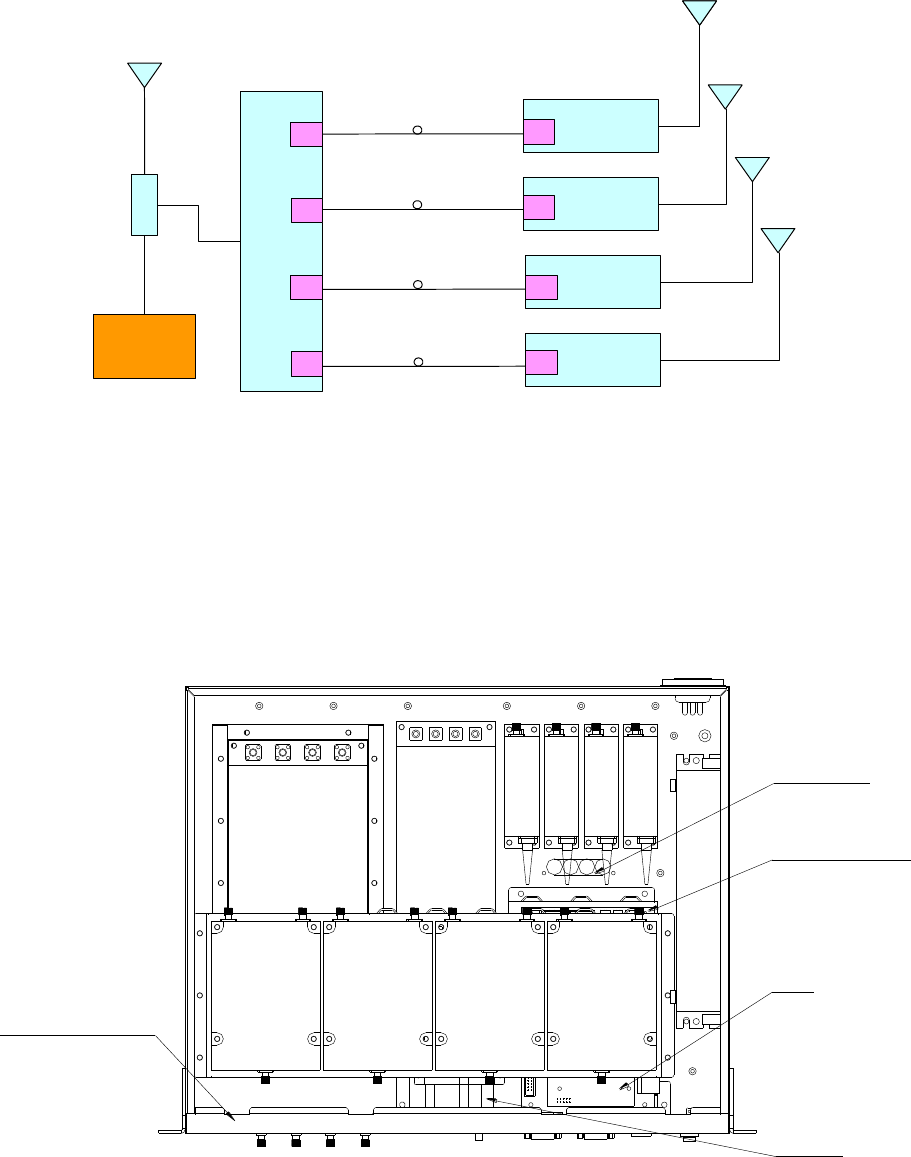
USER MANUAL FOR RA-5700
RA-5700 QI
Copyright - refer to title page
Page 15
ENU Status : 1-1-2
Tx/Rx
Tx/Rx
Coupler
BTS
MU
MT
MT
MT
MTMT
ANT
ANT
ANT
ANT
RU
RU
RU
RU
OP UL_DL
OP UL_DL
OP UL_DL
OP UL_DL
1310nm/1550nm
1310nm/1550nm
1310nm/1550nm
1310nm/1550nm
WDM
WDM
WDM
WDM
WDM
WDM
WDM
WDM
Figure 5: Application of One MU with Four RUs through four Optical Modules with WDM
2.3 EQUIPMENT LAYOUT
The MU RA-5700-D is constructed into a 19” shelf. It is connected via the connectors located on the front
panel. The RU RA-5700-R is designed for all cables entries from the bottom of the enclosure.
The internal layout for the MU is shown below:
UL Adaptor
Module
DL Adaptor
Module
Optical TX/RX
Module 1
Optical TX/RX
Module 2
Optical TX/RX
Module 3
Optical TX/RX
Module 4
Duplexer 1 Duplexer 2 Duplexer 3 Duplexer 4
PSU
MODEM
MCU
Distribution Board
Li-ion Battery
LED Indicator Board
Figure 6: MU Equipment Layout
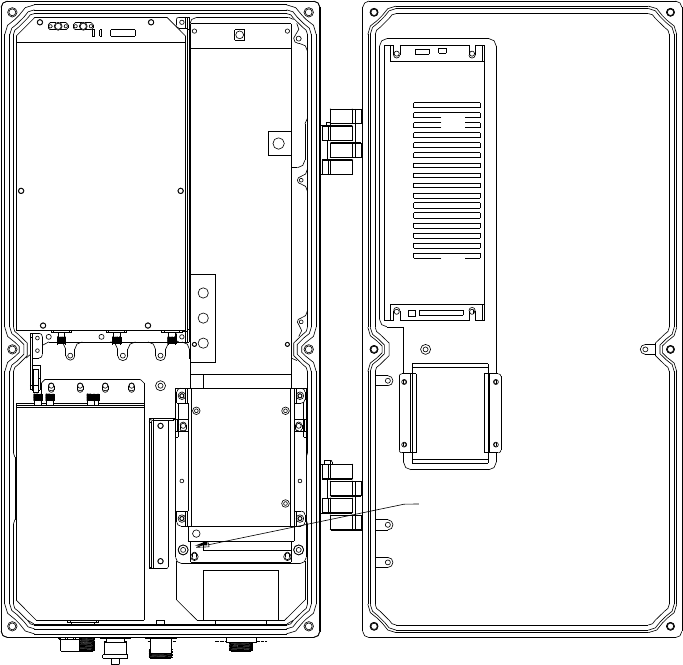
USER MANUAL FOR RA-5700
RA-5700 QI
Copyright - refer to title page
Page 16
ENU Status : 1-1-2
The internal layout for the RU is shown below:
PSU
Li-ion
Battery
Integrated
RF Module
DL PA
1900/850
Dualband
Combiner
MCU
Surge
Arrestor
700MHz Duplexer
Figure 7: RU Equipment Layout

USER MANUAL FOR RA-5700
RA-5700 QI
Copyright - refer to title page
Page 17
ENU Status : 1-1-2
2.4 EQUIPMENT CONSTITUTION
RA-5700 consists of MU and RU that consists of the modules described below:
The MU consists of:
Identifier
Functional Description
UL/DL Adaptor Module
Supports tri-band UL/DLRF Module, it splits and
combines UL/DL signal to complete filter, gain
control and power control.
Duplexer
Completes signal conversion.
Optical TX/RX Module
Completes optical signal and RF signal
conversion.
Main Control Unit (MCU)
Is used to control and monitor the operation
parameters of the MU and provides
telecommunication interface for local monitoring.
Distribution Board
Connects with modules and MCU; local
commissioning via RJ45 port.
Power Supply Unit (PSU)
Converts the input voltage into stable DC to
supply power for other modules and to charge the
internal Li-ion battery.
Li-ion Battery
Will supply power to MCU after power failure.
Table 1: MU Constitution
The RU consists of:
Identifier
Functional Description
Power Supply Unit (PSU)
Converts the input voltage into stable DC to supply
power for other modules and to charge the internal
Li-ion battery.
700MHz Duplexer
Fulfills 700MHz signal conversion.
1900/850 Dualband Combiner
Duplexes and combines both 1900MHz and
850MHz signals.
Optical TX/RX Module
Completes optical signal and RF signal
conversion.
Integrated RF Module
Combines the UL LNA and pre-amplifies the DL
signals.
DL PA Module
Amplifies the desired signal.
MCU
Is used to control and monitor the operation
parameters of the RU and provides
telecommunication interface for local monitoring.
Li-ion Battery
Will supply power to MCU after power failure.
Table 2: RU Constitution

USER MANUAL FOR RA-5700
RA-5700 QI
Copyright - refer to title page
Page 18
ENU Status : 1-1-2
2.5 KIT OF PARTS
For this system, the following are shipped:
Product Identifier
Description
Quantity
Fuse
N/A
2
N to SMA Connector
N female to SMA male
1
Modem Antenna
OOA-360/V02-SD
1
Feeder Cable
N male to N male; customized length accordingly
1
Field Commissioning Cable
N/A
1
Optical Jumper
FC/APC, 1m
1
Power Supply Cable
N/A
1
Philips Pan Head Screw
GB/T818, M5x10
4
Table 3: MU KOP
Product Identifier
Description
Quantity
Allen Key
5mm
1
Clamp
T3-099901-5202
2
Carriage Bolt (L>120)
M12x160
4
External Alarm Cable
N/A
1
Field Commissioning Cable
N/A
1
Fuse
N/A
2
Hex Bolt
M8x12
4
Mounting Rack
RA-5700-5825
1
Masonry Bolt
M10x110
4
Nut
M12
8
Optical Jumper
1
Power Supply Cable
N/A
1
Plain Washer
Φ8
4
Spring Washer
Φ8
4
Factory Test Report
1
This manual on CD
1
Table 4: RU KOP
End of Section
USER MANUAL FOR RA-5700
RA-5700 QI
Copyright - refer to title page
Page 19
ENU Status : 1-1-2
3 INSTALLATION
3.1 WARNINGS AND ALERTS
Laser
Laser light can cause damage to eyes. Laser light is not visible. Viewing it directly does not cause pain.
The iris of the eye will not close when viewing a bright light. Consequently, serious damage to the retina of
the eye is possible. NEVER LOOK INTO THE END OF A FIBER WHICH MAY HAVE A LASER
COUPLED TO IT.
Radio Frequency Energies
There may be situations, particularly for workplace environments near high-powered RF sources, where
recommended limits for safe exposure of human beings to RF energy could be exceeded. In such cases,
restrictive measures or actions may be necessary to ensure the safe use of RF energy.
High Voltage
The equipment has been designed and constructed to prevent, as far as reasonably, practicable danger.
Any work activity on or near equipment involving installation, operation or maintenance must be, as far as
reasonably, free from danger.
Where there is a risk of damage to electrical systems involving adverse weather, extreme temperatures,
wet, corrosive or dirty conditions, flammable or explosive atmospheres, the system must be suitably
installed to prevent danger.
Protective Earthing
Equipment provided for the purpose of protecting individuals from electrical risk must be suitable for the
purpose and properly maintained and used.
Handling Precautions
This covers a range of activities including lifting, lowering, pushing, pulling, carrying, moving, holding or
restraining an object, animal or person. It also covers activities that require the use of force or effort, such
as pulling a lever, or operating power tools.
Electrostatic Discharge (ESD)
Observe standard precautions for handling ESD-sensitive devices. Assume that all solid-state electronic
devices are ESD-sensitive. Ensure the use of a grounded wrist strap or equivalent while working with
ESD-sensitive devices. Transport, store, and handle ESD-sensitive devices in static-safe environments.
USER MANUAL FOR RA-5700
RA-5700 QI
Copyright - refer to title page
Page 20
ENU Status : 1-1-2
3.2 SITE PLANNING CONSIDERATIONS
Site Considerations
The MU can be located indoors to facilitate coupling of BTS signals and power supply connections. The
ALC range of received BTS signal is -10~10 dBm. Hence, an appropriate coupler must be used according
to the BTS output power.
The site consideration for RU is listed below:
The distance between the service antenna of RU and coverage area should satisfy line of sight
requirements for maximum coverage area.
The maximum fiber length is 13km, with a maximum path loss of 5dB.
The system delay of the optical system must be taken into consideration when there are neighboring
BTS sites overlapping in coverage.
Installation Location
Mounting surface shall be capable of supporting the weight of the equipment.
In order to avoid electromagnetic interference, a proper mounting location must be selected to minimize
interference from electromagnetic sources such as large electrical equipment.
Environmental
Humidity has an adverse effect on the reliability of the equipment. It is recommended to install the
equipment in locations having stable temperature and unrestricted air-flow.
The installation location for the system should be well ventilated. The equipment has been designed to
operate at the temperature range and humidity level as stated in the product specifications that of
temperature ranges from 32~104 oF (MU)/ -27~122 oF (RU) and the relative humidity is at most
85%(MU)/95%(RU).
Direct day light to the RU should be avoided. If the direct day light temperature exceeds 104oF, a shelter
should be provided for it.
Powering
The power supply unit (PSU) provides power to all modules within the equipment. Depending on the
product variant, it is recommended that the PSU operates on a dedicated AC circuit breaker or fused
circuit.
Grounding Requirement
Verify that the equipment has been well grounded. This includes antennas and all cables connected to the
system. Ensure lightning protection for the antennas is properly grounded.
USER MANUAL FOR RA-5700
RA-5700 QI
Copyright - refer to title page
Page 21
ENU Status : 1-1-2
Cable Routing
Depending on equipment configuration, a variety of types of cables are connected to the MU and RU:
coaxial cables, optical fibers, power cable, communication cable, and commissioning cable. Where
applicable, ensure cables are properly routed and secured so that they are not damaged.
Manual Handling
During transportation and installation, take necessary handling precautions to avoid potential physical
injury to the installation personnel and the equipment.
3.2.1 SYSTEM INSTALLATION CHECKLIST
Working space available for installation and maintenance for each mounting arrangement. Ensure
unrestricted airflow.
Ensure earthing point is within reach of the ground wire.
Ensure a power source is within reach of the power cord and the power source has sufficient capacity.
Where appropriate, ensure unused RF connectors are terminated.
Where appropriate, ensure unused optical fiber connectors are protected.
Do not locate the equipment near large transformers or motors that may cause electromagnetic
interference.
Reduce signal loss in feeder cable by minimizing the length and number of RF connections.
Ensure the equipment will be operated within the stated environment (refer to datasheet).
Where needed, couple BTS RF signal with a coupler to prevent damaging the equipment.
Where appropriate, confirm available of suitably terminated grade of RF and optical fiber.
Observe handling of all cables to prevent damage.
USER MANUAL FOR RA-5700
RA-5700 QI
Copyright - refer to title page
Page 22
ENU Status : 1-1-2
3.3 INSTALLATION PROCEDURES
3.3.1 GOODS INWARDS INSPECTION
RA-5700 was factory tested, inspected, packed, and delivered to the carrier with utmost care. Do not
accept shipment from carrier which shows damage or shortage until the carrier's agent endorses a
statement of the irregularity on the face of the carrier's receipt. Without documentary evidence, a claim
cannot be processed.
Open and check each package against the packing list. For any shortage, contact Comba Telecom
Systems. Do not remove items from packing materials until installation.
3.3.2 TOOLS
See Appendix B for a full list of tools required for installation and maintenance.
3.3.3 PREPARATION
Optical Fiber:
Fiber optic cables require proper handling. Do not stretch, puncture, or crush the fiber cable(s) with
staples, heavy equipment, doors, etc.
Always maintain the minimum bending radius specified by the cable manufacturer. The minimum
bend radius is usually 10 times as the cable's outer diameter. In the case of single optical fiber that is
not in a cable, the minimum bending radius to be observed is 1.181inch.
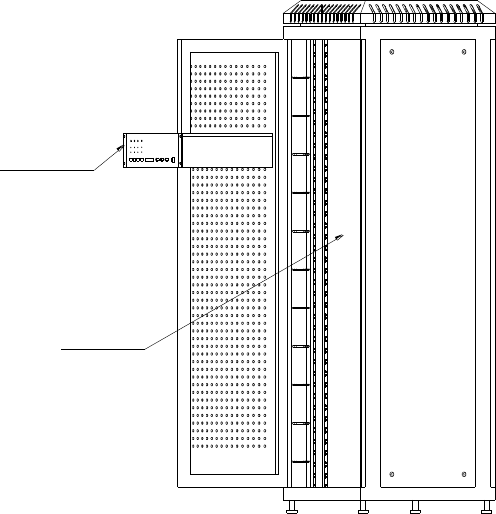
USER MANUAL FOR RA-5700
RA-5700 QI
Copyright - refer to title page
Page 23
ENU Status : 1-1-2
3.3.4 CABINET MOUNTING OF MU
Depending on the installation, should 2-post open-rack are to be used, the mid-mounting brackets are to
be used. For rack or cabinet mounting, the mid-mounting brackets are to be removed from the 4U shelf.
Cage nut and screws are not supplied. Unless being recommended by rack manufacturer, M5 cage nut /
bolt are to be used.
Master Unit
19" Shelf
Figure 8: Cabinet Mounting of 19” Shelf
3.3.5 RU MOUNTING RACK DIMENSION
The mounting arrangement of the RU is used for mounting the RU to a wall. The figure below shows the
location of the holes for the mounting tabs.
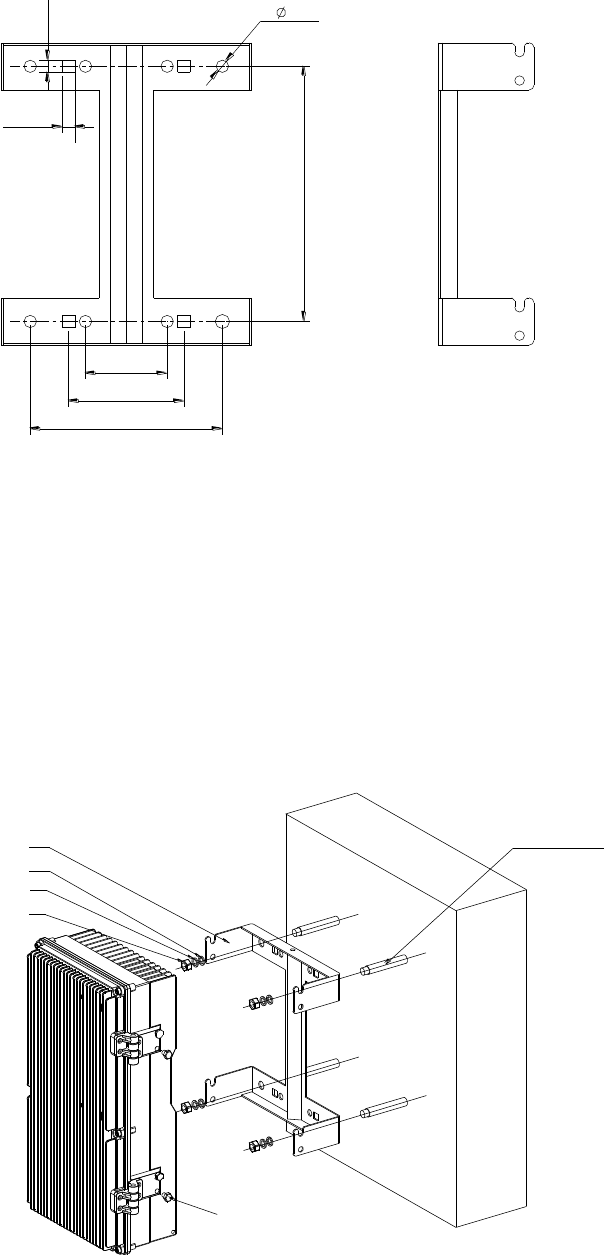
USER MANUAL FOR RA-5700
RA-5700 QI
Copyright - refer to title page
Page 24
ENU Status : 1-1-2
10.63
7.87
4.72
3.35
0.51
0.51
8- 0.51
Figure 9: RU Mounting Rack Dimension
3.3.6 WALL MOUNTING OF RU
Hereinafter are the mounting steps for wall mounting:
Drill holes on the wall for masonry bolts according to the dimension of the upper/lower mounting tabs
indicated above.
Insert the masonry bolts (M10x110) to the wall.
Hook the enclosure onto the masonry bolts, and then lower the whole enclosure to make sure that
the bolts are fastened into the narrow slots of the mounting tabs.
Tighten nuts to secure the hex bolts and enclosure onto the wall.
M8x12 Hex Bolt
Mounting Rack
Plain Washer
Spring Washer
M10 Nut
Masonry Bolt
Figure 10: RU Wall Mounting
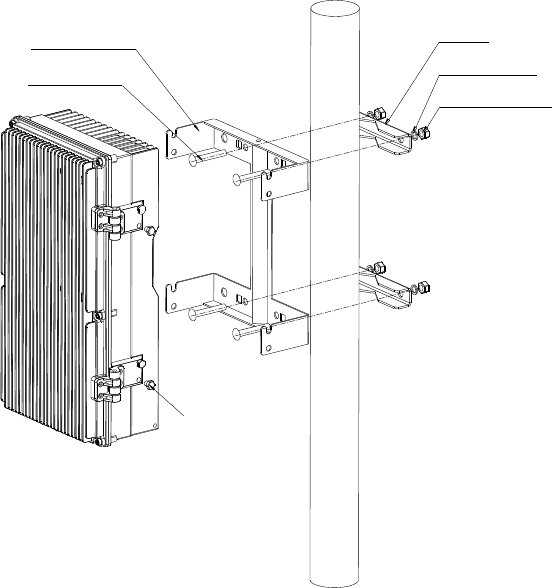
USER MANUAL FOR RA-5700
RA-5700 QI
Copyright - refer to title page
Page 25
ENU Status : 1-1-2
3.3.7 POLE MOUNTING OF RU
Secure the Mounting rack onto the pole using U bolt.
Hook the enclosure up onto the mounting rack and align the hole positions to that of the mounting
rack, then installed the rack bolts.
Use spanner to tighten hex bolts (M8x12) to mounting rack to complete the installation.
Mounting Rack
Carriage Bolt
Clamp
Plain Washer
Spring Washer
M8x12 Hex Bolt
Figure 11: Pole Mounting of RU
3.3.8 DRIP-LOOP
Comba recommends that every horizontal cable entry to the equipment forms a 'U' before it‟s entry to the
equipment. Any accumulated water on the cable will drip down at the bottom of the loop and will not climb
up to the equipment.
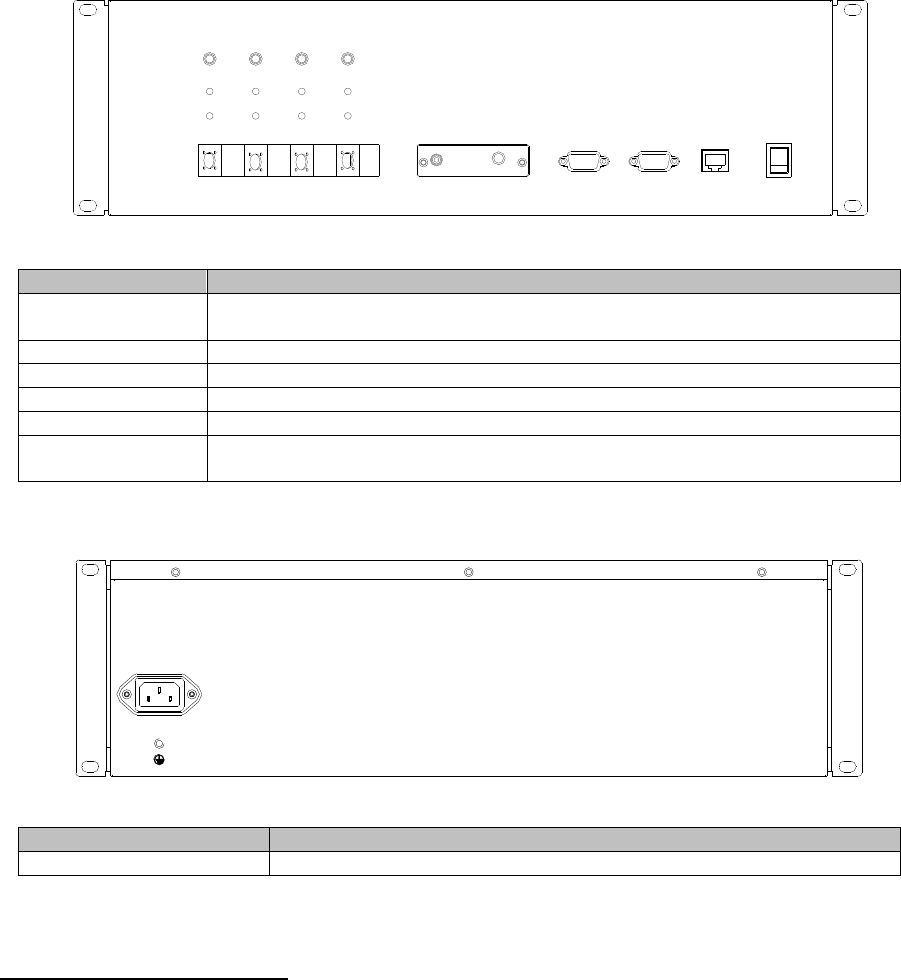
USER MANUAL FOR RA-5700
RA-5700 QI
Copyright - refer to title page
Page 26
ENU Status : 1-1-2
3.4 EQUIPMENT CONNECTORS
The MU is connected via the connectors located on the front and back panel. The RU is designed for all
cables entries from the bottom of the enclosure. The figures below present the connectors of MU and RU.
3.4.1 MU CONNECTORS
Connectors on the MU are identified as below:
700MHz 850MHz1900MHz AWS
OP3 OP4OP2
OP1
PWR MOD
ALM
RUN
OP4OP3OP2OP1 MODEM BTS_ALM OMT
EXT_ALM
Figure 12: MU Front Panel Connectors
Identifier
Functional Description
700MHz, 850MHz,
1900MHz, AWS
RF connector for various network systems.
EXT_ALM
DB9 (female) connector, for external alarm.
OP1~OP4
FC/APC optic interface, each interface is used to connect with a RU.
MODEM
Includes SIM insertor, MODEM indicator and MODEM RF connector.
BTS_ALM
DB9 (female) connector.BTS external alarm reporting,
OMT
RJ45 connector, local OMT commissioning port, connects with PC to realize
local commissioning.
Table 5: MU Front Panel Connections
100-240V~
50/60Hz
Figure 13: MU Back Panel Connectors
Identifier
Functional Description
100-240V~50/60Hz1
A power supply cable for power supply
Table 6: MU Back Panel Connections
1 The voltage identification is a variant due to electricity system diversity of global regions. The power cable gland
might be identified for AC 220V, AC 110V, AC 220V/110V, DC -48V, or DC +24V respectively. Please refer to
specific product or contact local sales if any doubt.
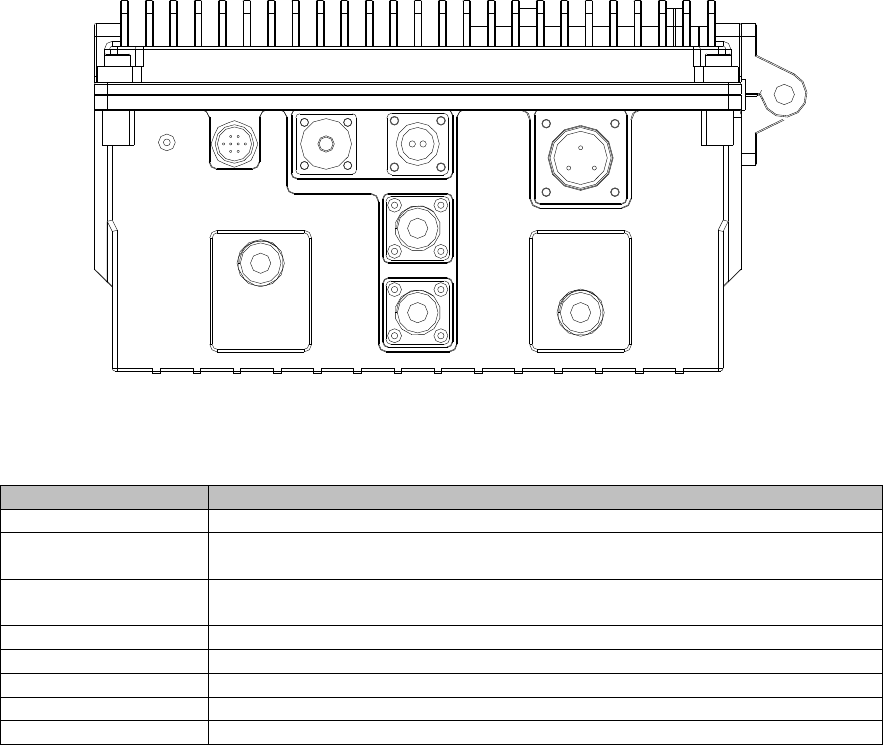
USER MANUAL FOR RA-5700
RA-5700 QI
Copyright - refer to title page
Page 27
ENU Status : 1-1-2
3.4.2 RU CONNECTORS
Connectors on the RU are identified below:
100-240V~ 50/60Hz
ANT 700
TX_EXT
RX_EXT
850+1900
ANT
EXT_ALM OP OUT/IN
OMT
Figure 14: RU Connectors
Identifier
Functional Description
100-240V~50/60Hz
A power supply cable for power supply
ANT 850+1900,
ANT700
Connect with TX/RX antenna via coaxial cable.
OP OUT/IN
OP uplink/downlink FC/APC optic connector, connects with MU OP
connector via optical fiber.
OMT
Connects with PC to fulfill local commissioning.
EXT_ALM
7-pin CPC connector, for external alarm..
TX_EXT
N-female connector, for TX output extension of a new band.
RX_EXT
N-female connector, for RX input extension of a new band.
ALM LED Indicator
Synchronized indicator of LED4 on MCU
Table 7: RU Connections

USER MANUAL FOR RA-5700
RA-5700 QI
Copyright - refer to title page
Page 28
ENU Status : 1-1-2
3.5 EQUIPMENT CONNECTION
3.5.1 GROUNDING CONNECTION
Ground connection
To ensure safe operation of the product, a ground (earth) connection is required. For single phase AC
power source, the product must be grounded by connecting the “earth wire” of the power cord to the
ground terminal of the AC supply. For operating this product with DC power system (such as rectifiers),
the product should not be connected to power systems that switch open the return lead because the
return lead could function as the ground (earth) connection for the equipment.
Protective Ground Connection
The enclosure must be grounded securely by connecting a copper wire (CSA 16mm2) to the grounding
terminal on the equipment/rack, and the other end to a protective ground (i.e. building earth point). An
internationally acceptable colour code of the ground connection wire is green/yellow.
Such a ground connection implements the “Protective Ground Connection”, and must be connected to the
equipment at the designated ground point. In general, do not connect the supply before establishing an
adequate ground (earth) connection.
MU Grounding Connection
Connect the grounding terminal located on the back panel of MU to a protective ground (i.e. building earth
point).
RU Grounding Connection
The equipment must be grounded securely. Connect a copper wire to the grounding terminal on the
mounting tab/enclosure, and connect the other end to a protective ground (i.e. building earth point). An
internationally acceptable coloring code of the ground connection wire is green/yellow.
3.5.2 LI-ION BATTERY CONNECTION
Li-ion battery is provided with this system to ensure power is supplied to the system monitoring unit and
MCU and to ensure the alarm message could be sent to OMC effectively in case of mains power failure.
Caution: Be careful of the risk of explosion if battery is replaced by an incorrect type. Dispose of used
batteries according to the instructions.
3.5.3 OPTICAL CONNECTION
MU is connected to RU via optical fiber (length<13km). Connect MU front panel‟s OP1-OP4 with RU‟s OP
interfaces respectively.
Refer to the following connection:
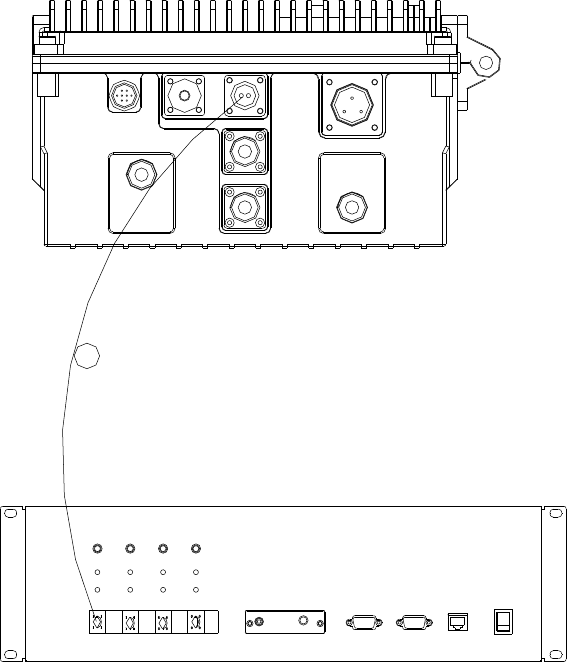
USER MANUAL FOR RA-5700
RA-5700 QI
Copyright - refer to title page
Page 29
ENU Status : 1-1-2
EXT_ALM OMT
BTS_ALM
MODEMOP1 OP2 OP3 OP4
RUN ALM MODPWR
OP1 OP2 OP4OP3
AWS
1900MHz850MHz
700MHz
100-240V~50/60Hz
ANT
700
TX_EXT
RX_EXT
850+1900
ANT
EXT_ALM OP OUT/IN
OMT
Figure 15: Optical Connection
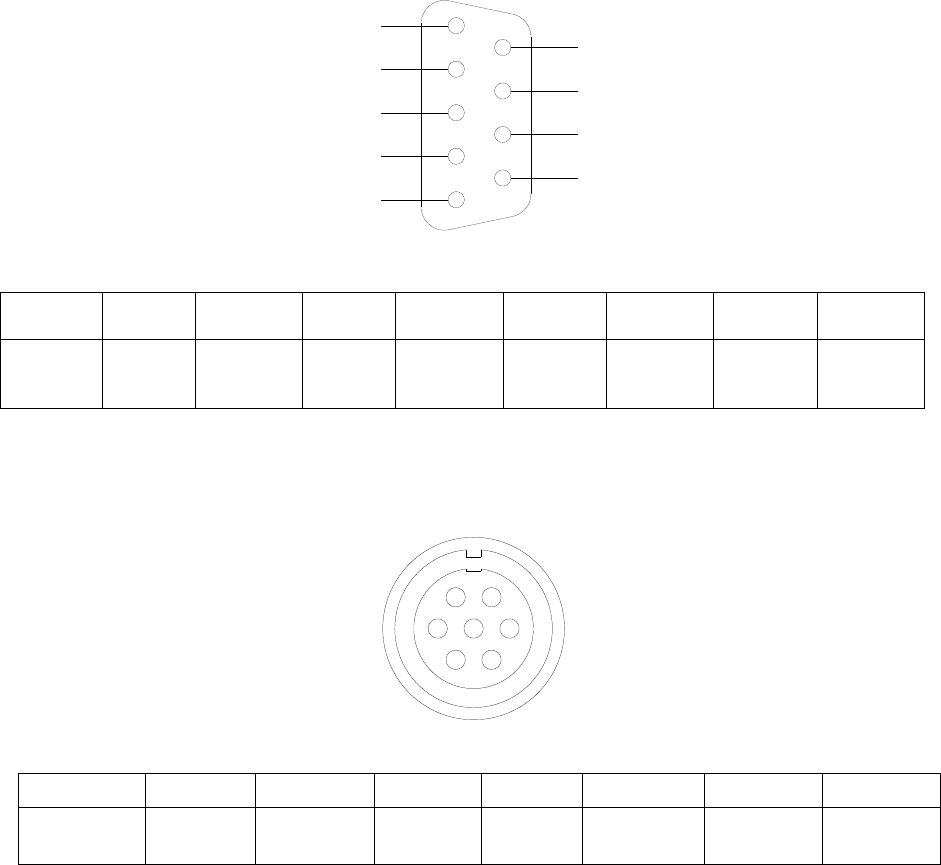
USER MANUAL FOR RA-5700
RA-5700 QI
Copyright - refer to title page
Page 30
ENU Status : 1-1-2
3.5.4 EXTERNAL ALARM CONNECTION
For MU, this is a DB9 connector. The following figure and table show the pin allocation and definition. Pin
numbering are shown looking-into the connector on the enclosure.
EXT_ALM
EXT_ALM
EXT_ALM
EXT_ALM 8
9
7
6
5
3
4
2
1
Figure 16: Pins Allocation for “EXT_ALM” Port for MU
Pin
number
1
2
3
4
5
6
7
8~9
Alarm
definition
EXT.
Alarm 1
Reserved
EXT.
Alarm
2
Reserved
EXT.
Alarm 3
Reserved
EXT.
Alarm 4
Reserved
Table 8: Pin Definition of “EXT_ALM” Port for MU
For RU, this is a 7-pin CPC connector. The following figure and table show the pin allocation and
definition. Pin numbering are shown looking-into the connector on the enclosure.
7
6
35
4
1 2
Figure 17: Pins Allocation for “EXT_ALM” Port for RU
Pin number
1
2
3
4
5
6
7
Alarm
definition
EXT.
Alarm 1
EXT.
Alarm 2
EXT.
Alarm 3
GND
Reserved
Reserved
Reserved
Table 9: Pin Definition of “EXT_ALM” Port for RU
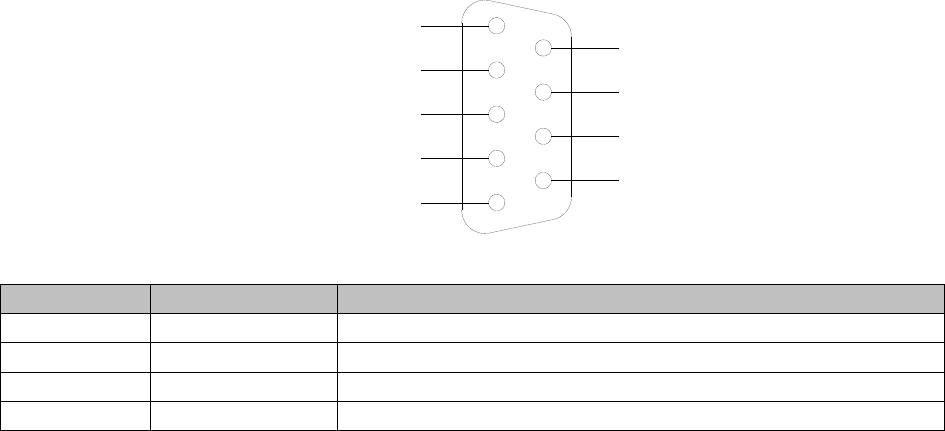
USER MANUAL FOR RA-5700
RA-5700 QI
Copyright - refer to title page
Page 31
ENU Status : 1-1-2
3.5.5 BTS ALARM CONNECTION
The equipment alarms can be signaled to the BTS via voltage-free relay contacts. The voltage-free relay
connections are connected to the DB-9 port “BTS_ALAM” located on the MCU of MU. The following figure
and table shows the pin allocation and definition.
1
2
4
3
5
6
7
9
8
BTS_OPEN
BTS_CLOSE
BTS_ COM
Figure 18: Pins Allocation for “BTS_ALM” Port
Pin Number
Definition
Description
1
BTS_OPEN
Connects to the open terminal of the voltage free relay.
2
BTS_COM
Connects to the common terminal of the voltage free relay.
3
BTS_CLOSE
Connects to the close terminal of the voltage free relay.
4 ~ 9
NC
Reserved.
Depending on OMT/OMC configuration, alarm to BTS can be signalled equipment by either: a) pin1 and
pin2 „open‟ or b) Pin2 and Pin3 „close‟.

USER MANUAL FOR RA-5700
RA-5700 QI
Copyright - refer to title page
Page 32
ENU Status : 1-1-2
3.5.6 CONNECT TO PC
The local commissioning and management for MU and RU is achieved through connecting to the OMT
PC locally.
Connect MU to PC
Connect”OMT” port (RJ45) to the serial port of PC with ethernet cable supplied to achieve local monitoring
and management. A build-in wireless modem is available for OMC connection to realize remote
commissioning.
Connect RU to PC
Local commissioning and management of RU is achieved through “OMT” port and the OMT PC via field
commissioning cable supplied.
With the equipment enclosure opened, the engineering OMT can be used to connect internally.
End of Section
USER MANUAL FOR RA-5700
RA-5700 QI
Copyright - refer to title page
Page 33
ENU Status : 1-1-2
4 COMMISSIONING
4.1 PRE-COMMISSIONING TASKS
After equipment installation, perform the following steps before equipment powering and commissioning,
check that the expected voltage, current, and power levels do not violate any ratings. Double check all
connections including ground before applying power. Do not manipulate circuits or make changes when
power is applied:
Visually inspect the power connection within the equipment. Ensure that the power cable is correctly
and securely connected, including grounding wire, RF cable and optical cable.
Check grounding connection and verify that the ground resistance is less than 5Ω.
Connect the equipment to the PC installed with OMT software.
With the MU switched on, RU installed and all cablings connected, apply power to the RU by switching
on the PSU switch on the integrated PSU.
Monitor the initialization of the MU though the LEDs on the front panel of MCU unit, while for RU, it is
through the LEDs on the MCU unit integrated. Refer to detailed LEDs information in the next section.
4.2 MU/RU RESET TIME DURATION
To reset the MU and RU, system takes MU<90s and RU<50s.
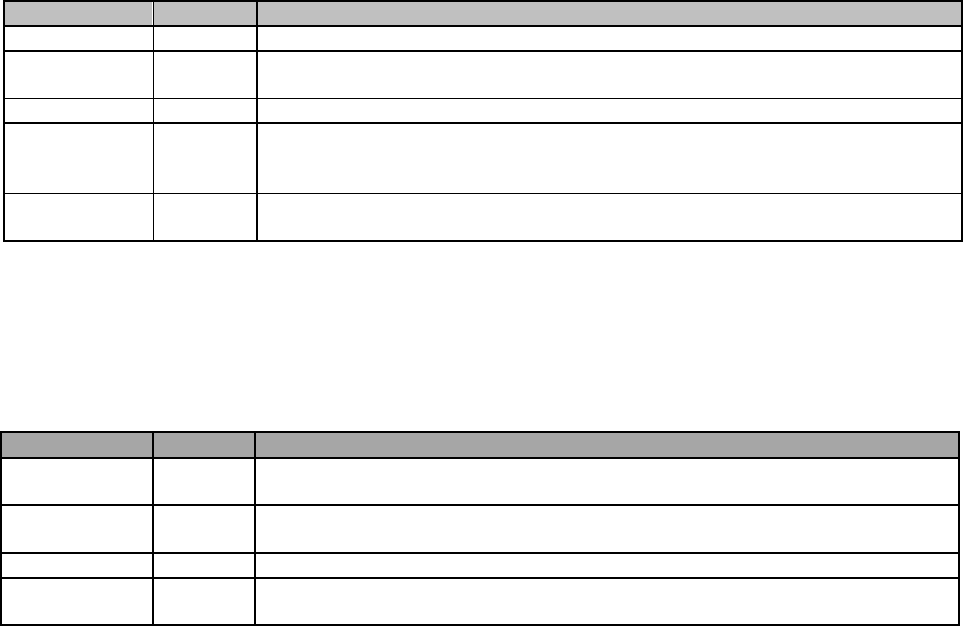
USER MANUAL FOR RA-5700
RA-5700 QI
Copyright - refer to title page
Page 34
ENU Status : 1-1-2
4.3 LED INDICATORS
4.3.1 MU LED INDICATORS
Diagnostic LEDs are located on the MU; each indicates the status of a particular function:
Identifier
Color
Indication
POWER
Green
It stands in green when power on.
RUN
Green
Operation indicator – power is supplied to the MU. Flashes once every
second to indicate normal system operation.
ALM
Red
Alarm indicator. ON = alarm; OFF = no alarm
MOD
Red
Diagnostic LED for FSK communication and MODEM operation. Flashes
once every two seconds to indicate normal communication between MU and
RU.
OP1-OP4
Green
When the green indicators are on, the relative optical channel is in normal
reception.
Table 10: MU LED Indicators
4.3.2 RU LED INDICATORS
LED Diagnostic indicators are located on the MCU integrated in the RU; each indicates the status of a
particular function.
Identifier
Colour
Indication
ALM (on
bottom panel)
Red
Synchronized LED indicator of LED4 on MCU. Alarm indicator. ON = alarm;
OFF = no alarm
LED 5
Green
Operation indicator – power is supplied to the RU. Flashes twice every 2
seconds to indicate normal system operation.
LED 4
Red
Alarm indicator. ON = alarm; OFF = no alarm
LED 3
Red
Diagnostic LED for FSK communication. Flashes once every two seconds to
indicate normal communication between MU and RU.
Table 11: RU LED Indicators
All LEDs in MU (except power indicator) will flash simultaneously 3 times after equipment power-up. Then
RUN indicator flashes every second to indicate system normal operation.
The LEDs LED5, LED4, LED3 will flash simultaneously 3 times after equipment power-up. During system
self-checking, LED5 flashes slowly. Then it flashes every second to indicate system commissioning can
be proceeded with.
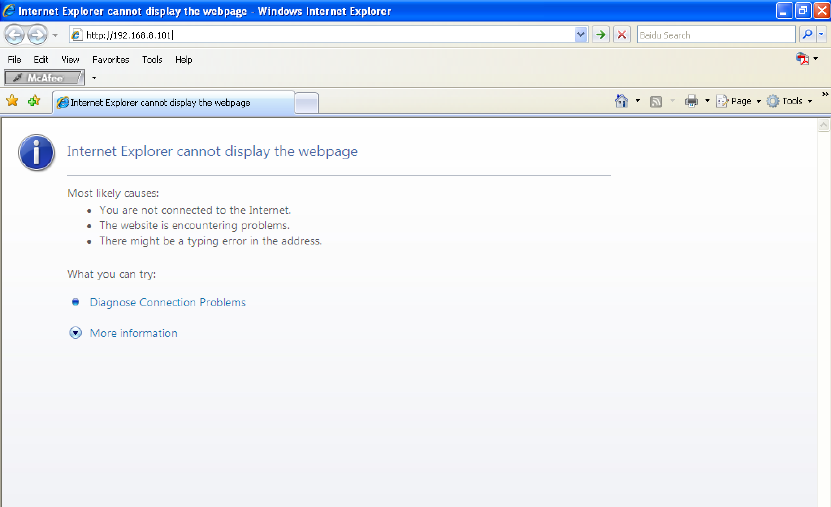
USER MANUAL FOR RA-5700
RA-5700 QI
Copyright - refer to title page
Page 35
ENU Status : 1-1-2
4.4 WEB OMT
4.4.1 CONNECTION FROM PC TO EQUIPMENT
Before accessing to the OMT, physical connection between the PC and the equipment must be made. A
straight-through RJ45 cable shall be applied for the connection.
Comba recommends an IE8 browser to connect with Web OMT.
The default IP address of RA-5700 MU is 192.168.8.101 and RU is 192.168.8.102. Subnet mask is
255.255.255.0.
Execute the IE browser and enter 192.168.8.101/102 in the address bar. A pop-up window will be shown,
requiring user name and password. The default user is admin and password is 123456.
Figure 19: Web OMT Access
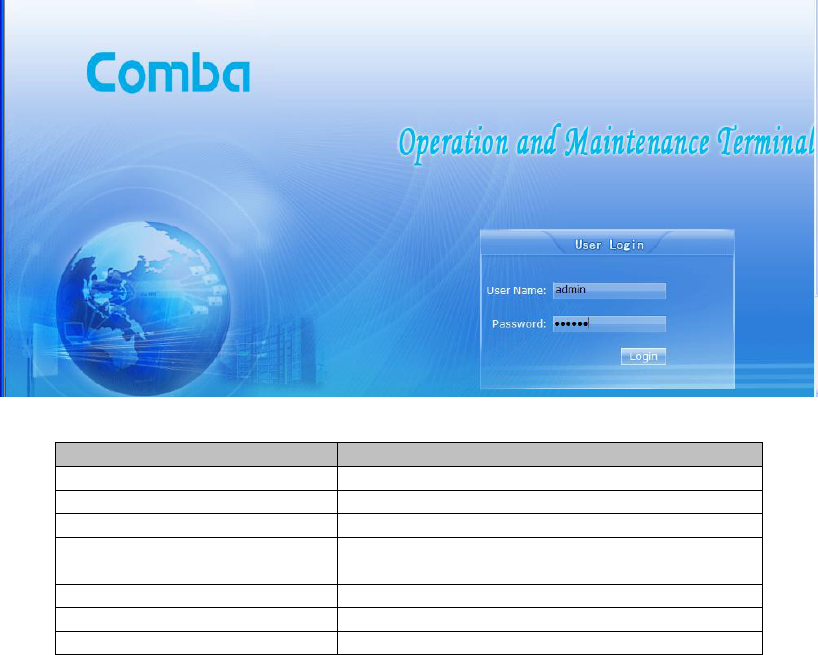
USER MANUAL FOR RA-5700
RA-5700 QI
Copyright - refer to title page
Page 36
ENU Status : 1-1-2
Figure 20: Log in
Items
Default Value
PC IP Address
Automatically distributed by system
PC Subnet Mask
255.255.255.0
PC Gateway
Automatically distributed by system
System IP Address
192.168.8.101 (for MU) / 192.168.8.102 (for
RU)
System Subnet Mask
255.255.255.0
User name
admin
Password
123456
Table 12: IP Setting Quick Look-up Table
4.4.2 OMT CONFIGURATION
OMT parameters include: Common Information, RF Information, Alarm Information, Properties
Information, User Manager and Help.
4.4.3 SYSTEM INFORAMTION
Click on [System Information], system information will be displayed in the right interface of the OMT
screen. In the interface the site ID of MU is described and the currently accessed unit is indicated.
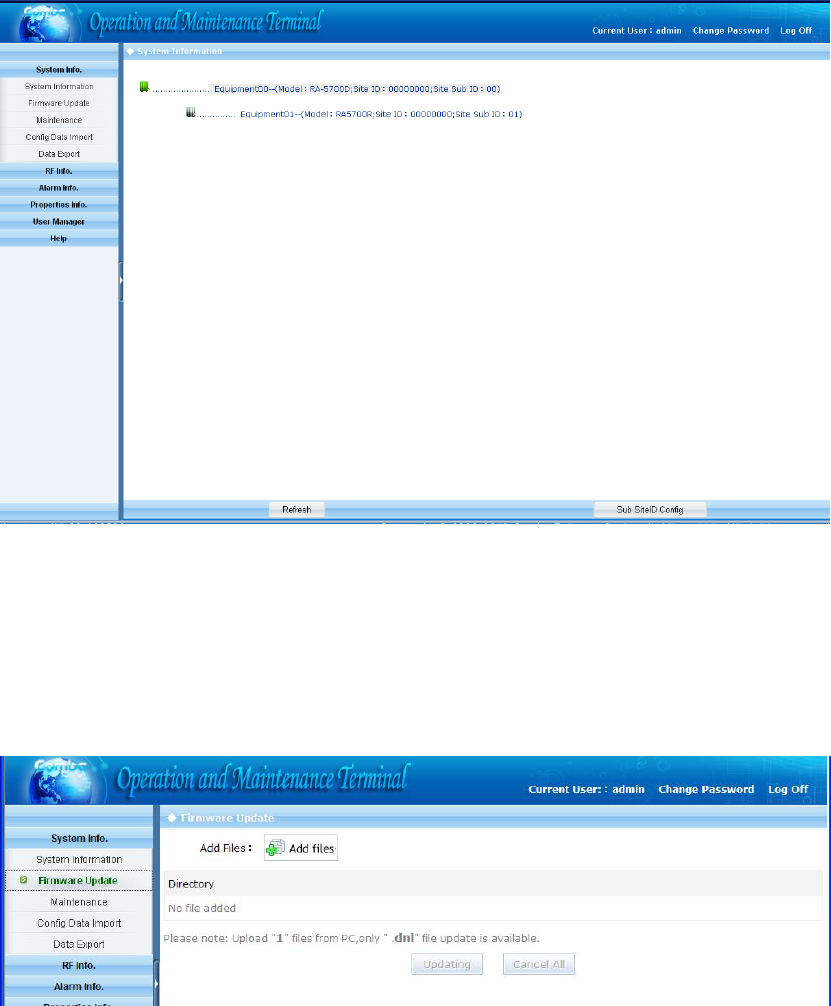
USER MANUAL FOR RA-5700
RA-5700 QI
Copyright - refer to title page
Page 37
ENU Status : 1-1-2
Figure 21: System Information
As illustrated, MU in green is under monitoring,
To switch to the RU or other sites, customer can choose RU (in grey) or other site by clicking to
switch to RU or other sites. It usually takes less than 40s.
Firmware Update
Figure 22: Firmware Update
For fiemware update, system takes approx 10mins based on the current version. Normally it takes
less than 3mins.
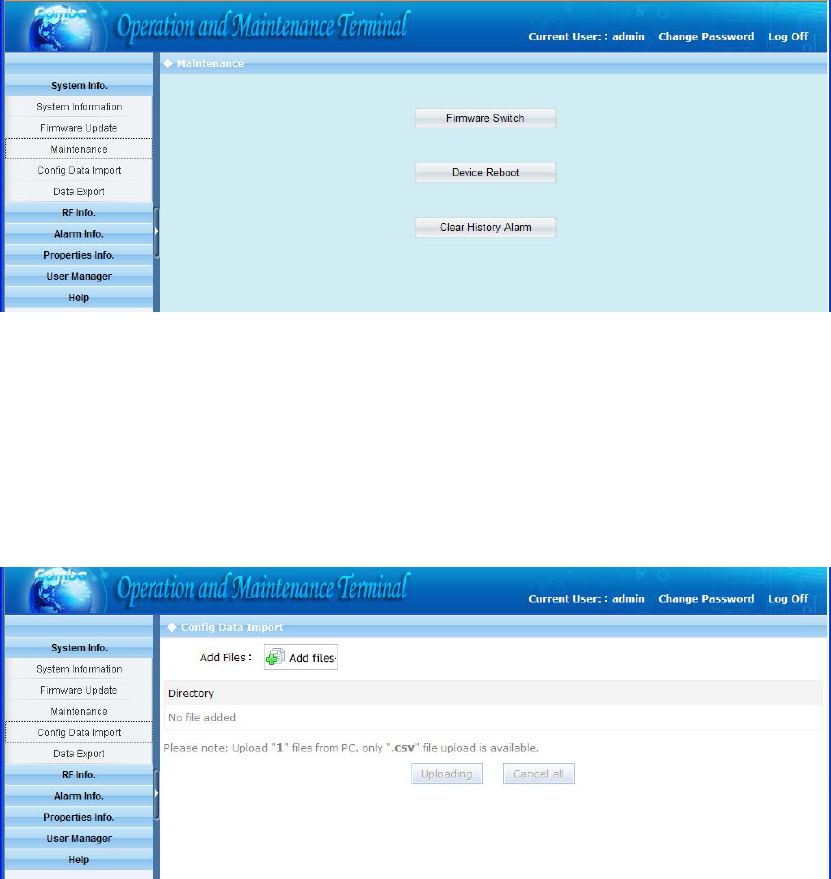
USER MANUAL FOR RA-5700
RA-5700 QI
Copyright - refer to title page
Page 38
ENU Status : 1-1-2
Maintenance
Figure 23: Maintenance
1> Firmware Switch: can switch to the previous firmware version which was saved in the system when
update to current firmware. It is to say there are 2 firmware versions available in same system. This
function is not available in current phase.
2> Device Reboot: restart the device
3> Clear History Alarm: delete all history alarm records
Config. Data Import
Figure 24: Data Import
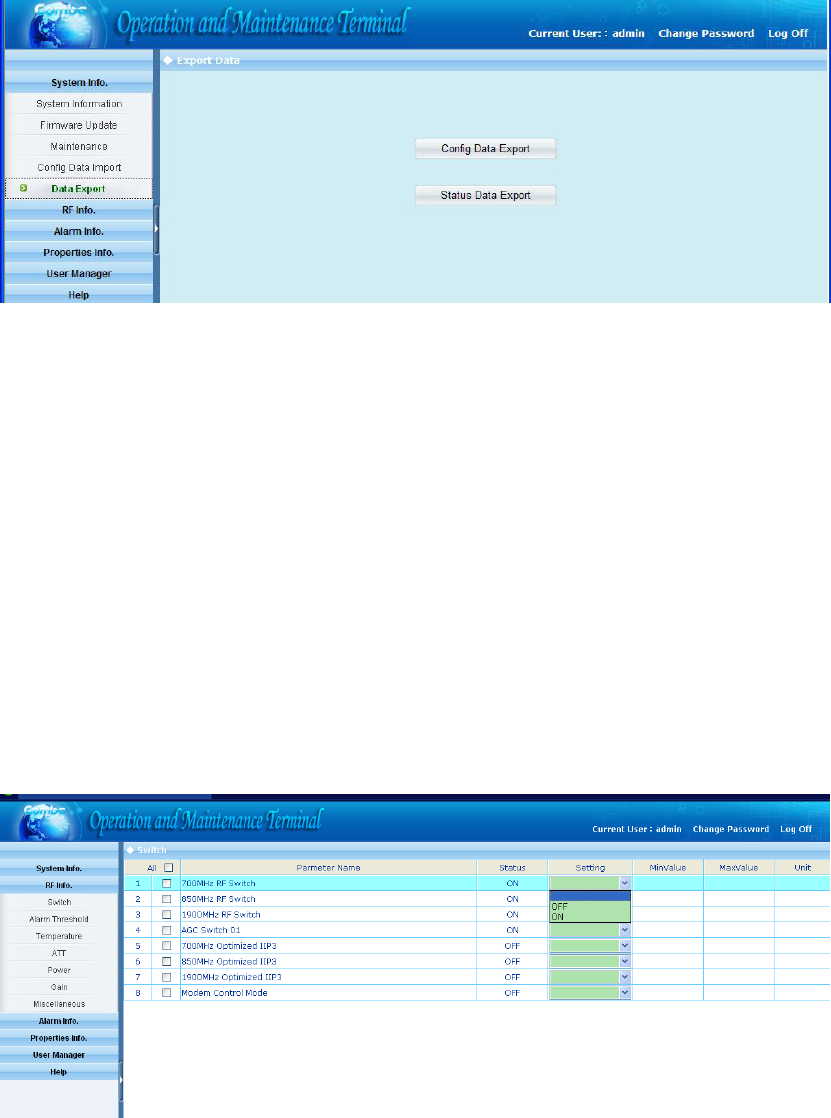
USER MANUAL FOR RA-5700
RA-5700 QI
Copyright - refer to title page
Page 39
ENU Status : 1-1-2
Data Export
Figure 25: Data Export
[Export]: Export all site records. The records can be exported to a CSV file.
1> Config Data Export: can export the config. data and save in PC. The exported data can be input to the
same kind of equipment if necessary.
2> Status Data Export: can export status data and save in PC. The data is save-only, can not import.
3> Usally, cofig a data import and export, it takes less than 5s.
4.4.4 RF INFORMATION
It is recommended to configure the following RF parameters for the first installation.
Switch
Switch is to enable/disable power for internal modules. When user checks and sets non-RF parameters,
such as checking physical antenna connection, switching off will disable equipment power temporarily to
protect PA in operation.
Figure 26: Switch
Config:
Select the required state in setting columns of RF information window for RF switch, then press [ON] or
[OFF] button to finish the configuration operation.
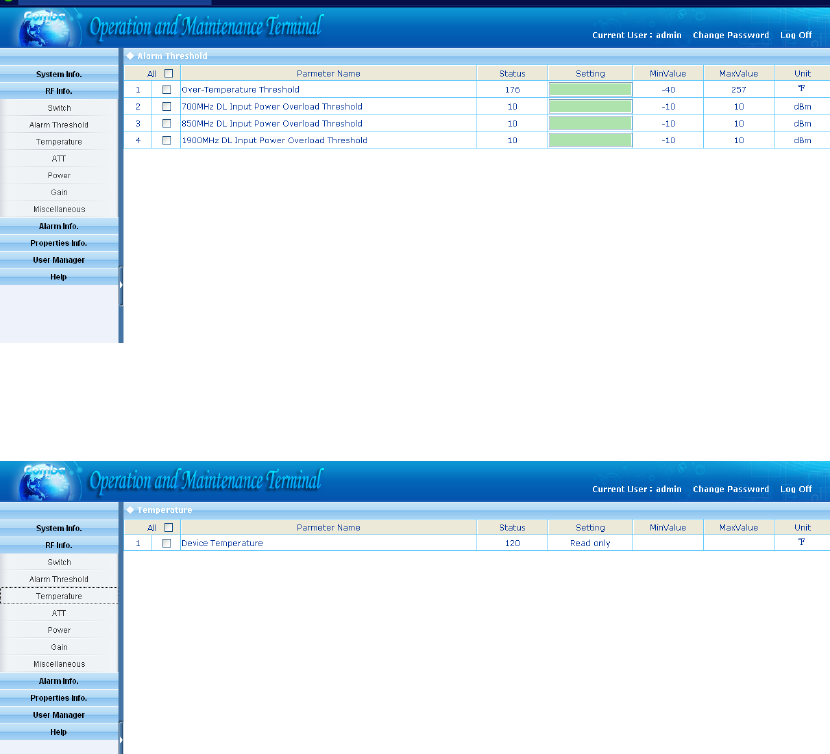
USER MANUAL FOR RA-5700
RA-5700 QI
Copyright - refer to title page
Page 40
ENU Status : 1-1-2
Alarm Threshold
Users can set alarm threshold according to the specific situation. If the measured value is lower than the
threshold lower limit or more than the threshold upper limit, the appropriate alarm will be generated.
Figure 27: Alarm Threshold
Temperature
Figure 28: Temperature
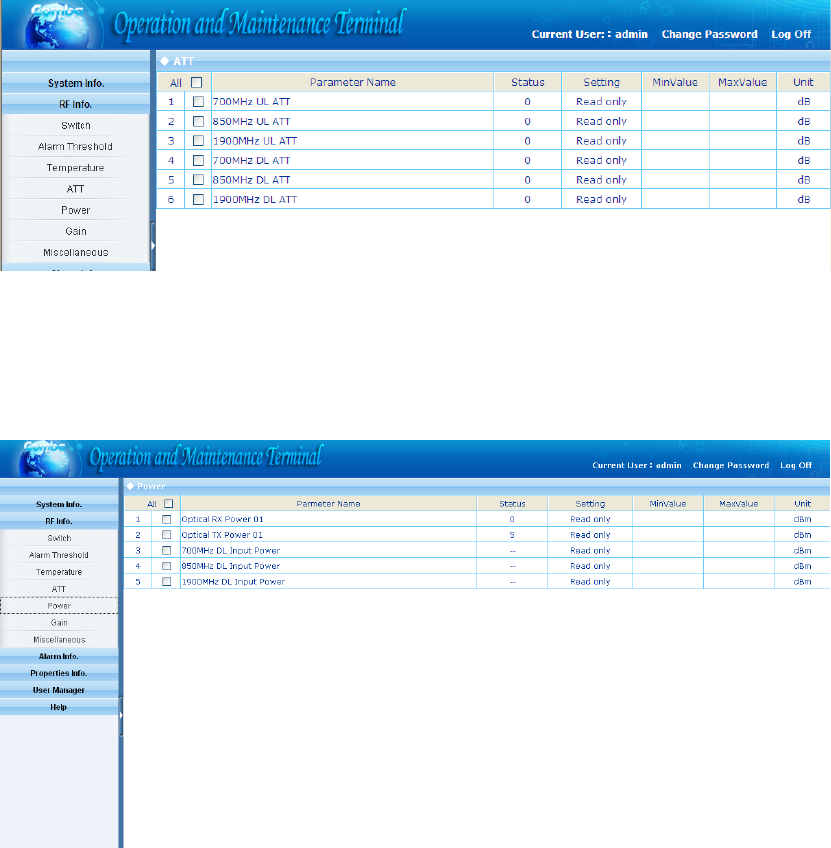
USER MANUAL FOR RA-5700
RA-5700 QI
Copyright - refer to title page
Page 41
ENU Status : 1-1-2
ATT
Figure 29: ATT
[ATT]: read-only parameters. ATT = Rating Gain - Gain
Power
Figure 30: Power
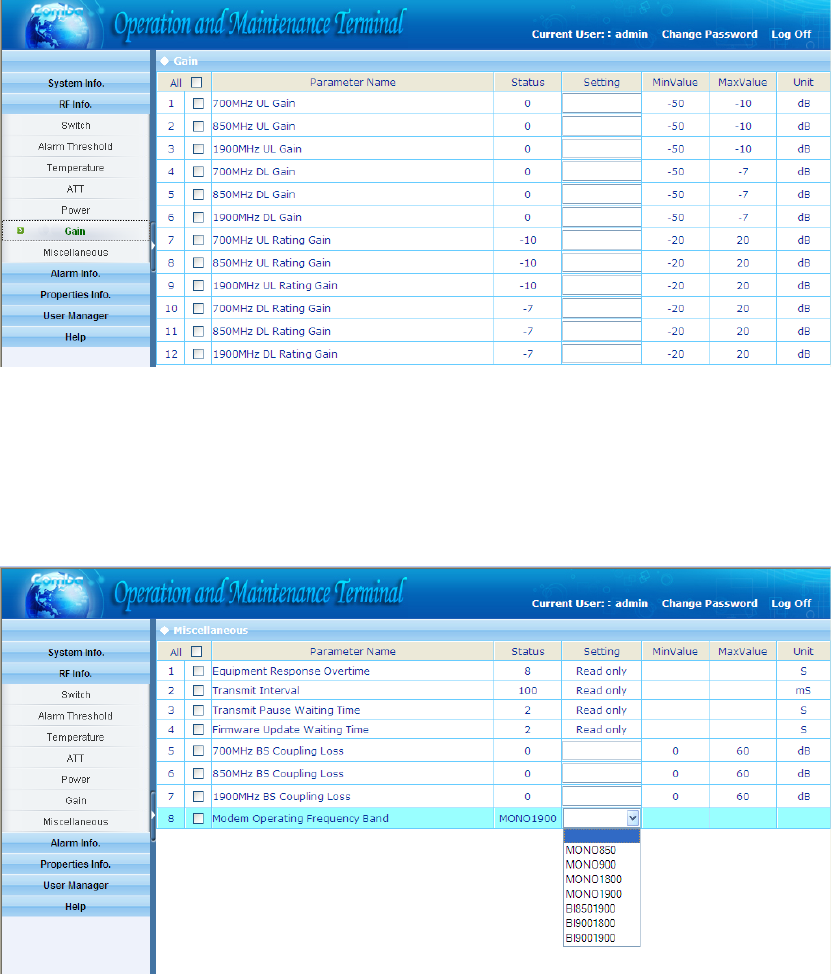
USER MANUAL FOR RA-5700
RA-5700 QI
Copyright - refer to title page
Page 42
ENU Status : 1-1-2
Gain
Figure 31: Gain
Rating Gain: be set before delivery. Comba recommends no change of rating gain value.
Gain: User can set according to the real application.
Miscellaneous
Figure 32: Miscellaneous
4.4.5 ALARM INFORMATION
Click any tree node in [Alarm Info] group, [Alarm Information] window will appear in the right side. The
figures below show the alarm information.
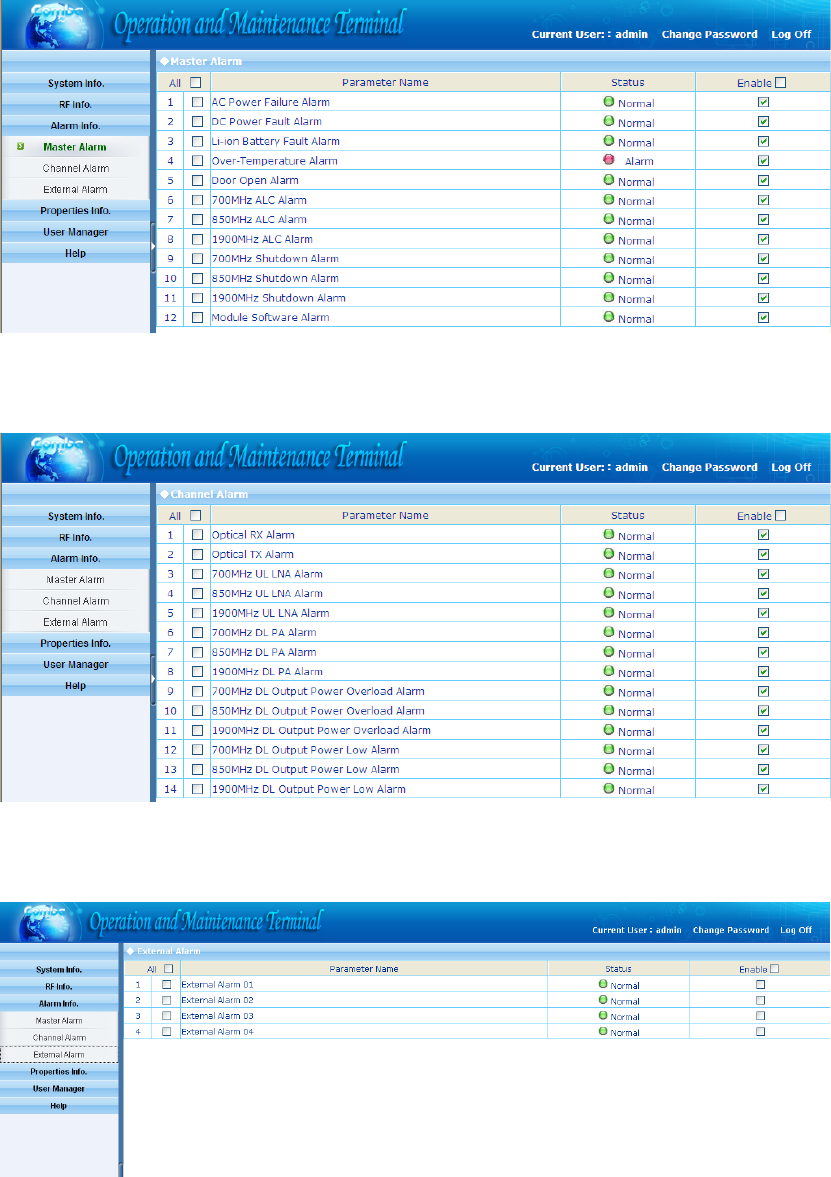
USER MANUAL FOR RA-5700
RA-5700 QI
Copyright - refer to title page
Page 43
ENU Status : 1-1-2
Master Alarm
Figure 33: Master Alarm
Channel Alarm
Figure 34: Channel Alarm
External Alarm
Figure 35: External Alarm
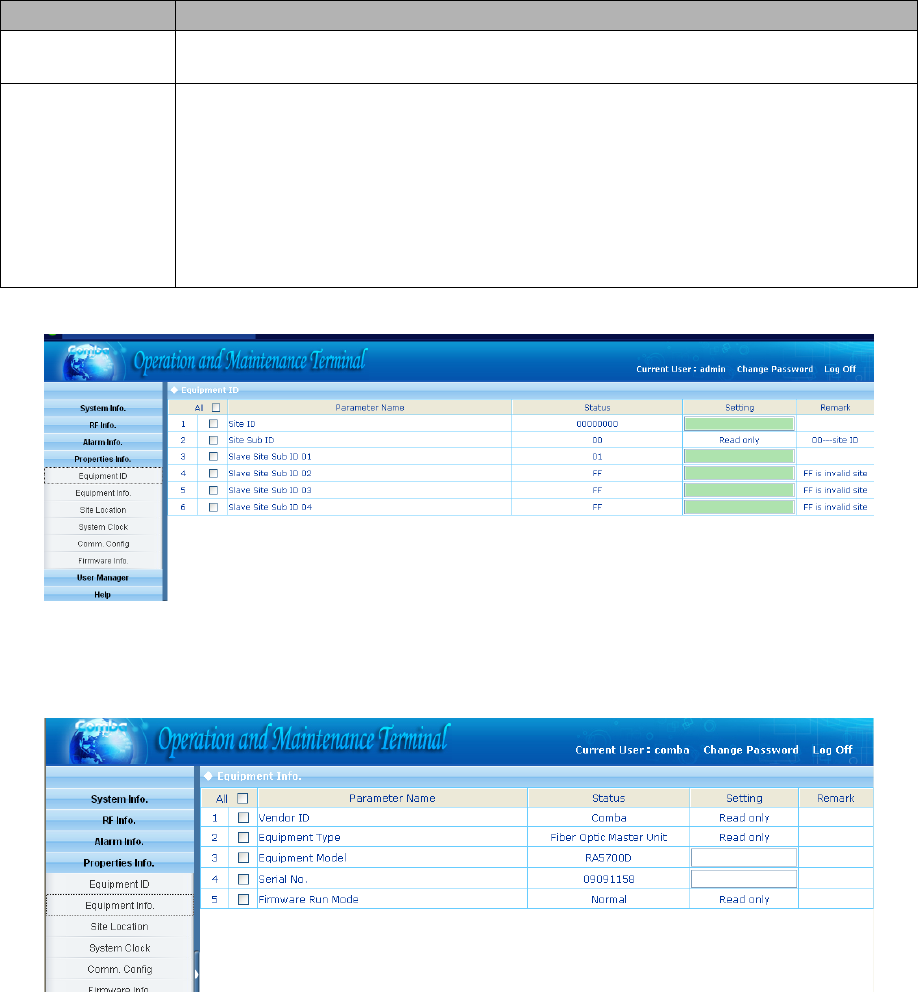
USER MANUAL FOR RA-5700
RA-5700 QI
Copyright - refer to title page
Page 44
ENU Status : 1-1-2
4.4.6 PROPERTIES INFORMATION
Equipment ID
Equipment ID is to be configured after local commission has been completed, which includes Site ID and
Site Sub ID.
Item
Description
Site ID
Site ID is the unique equipment identification. It is a hexadecimal string of eight
characters in the range of [0x00000000-0xFFFFFFFF]. e.g. 12345678
Site Sub ID
Site Sub ID is used for Master-Slave System. It is the unique identification of each
Master/ Slave Unit and is a hexadecimal string of two characters in the range of
[0x00-0xFF]
For the system located with single equipment, the Site Sub ID should be 0xFF.
e.g. 00
For Master-Slave system, the Site Sub ID for Master Unit is 0x00, and the Site
Sub ID for each Slave Unit is represented in the range of [0x00-0xFE] in
ascending order. e.g. Master Site ID: 00 Slave Site ID: 01
Table 13: Equipment ID
Figure 36: Equipment ID
Equipment Info.
Figure 37: Equipment Info.
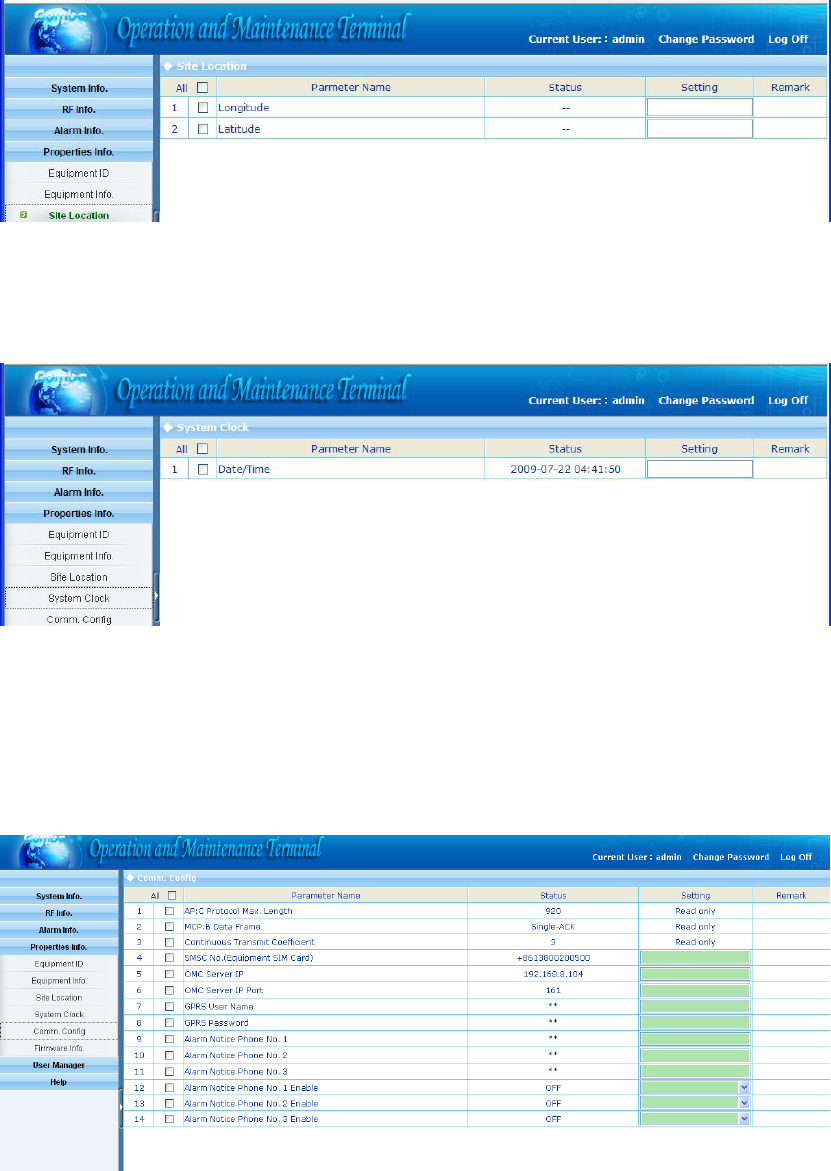
USER MANUAL FOR RA-5700
RA-5700 QI
Copyright - refer to title page
Page 45
ENU Status : 1-1-2
Site Location
Figure 38: Site Location
[Site Location]: input the current longitude and latitude in the blank.
System Clock
Figure 39: System Clock
[System Clock]: it shows the current time/date information. It is settable.
Comm. Config
The Comm. Config information requires to be manually entered by users after successful connection to
the equipment.
Figure 40: Comm. Config.
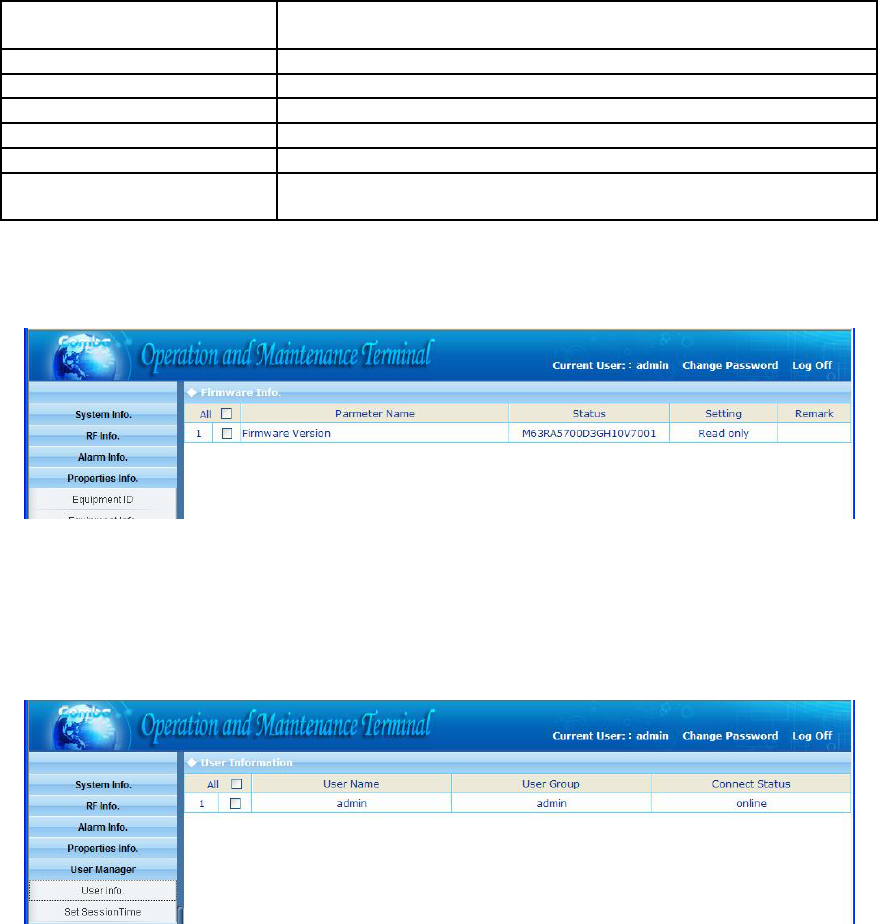
USER MANUAL FOR RA-5700
RA-5700 QI
Copyright - refer to title page
Page 46
ENU Status : 1-1-2
SMSC NO. (Equipment
SIM Card)
The SMS centre number of SIM card in equipment.
OMC Server IP
OMC IP Address. For equipment which support TCP/IP.
OMC IP Port No.
OMC IP Port No. For equipment which support TCP/IP.
GPRS User Name
Login GPRS network user name.
GPRS Password
Login GPRS network password.
Alarm Notice Phone NO.
The telephone number of alarm receiver.
Alarm Notice Phone NO.
Enable
Enable the telephone number of alarm receiver.
Firmware Information
Figure 41: Firmware Information
4.4.7 USER MANAGEMENT
User Info.
Figure 42: User Information
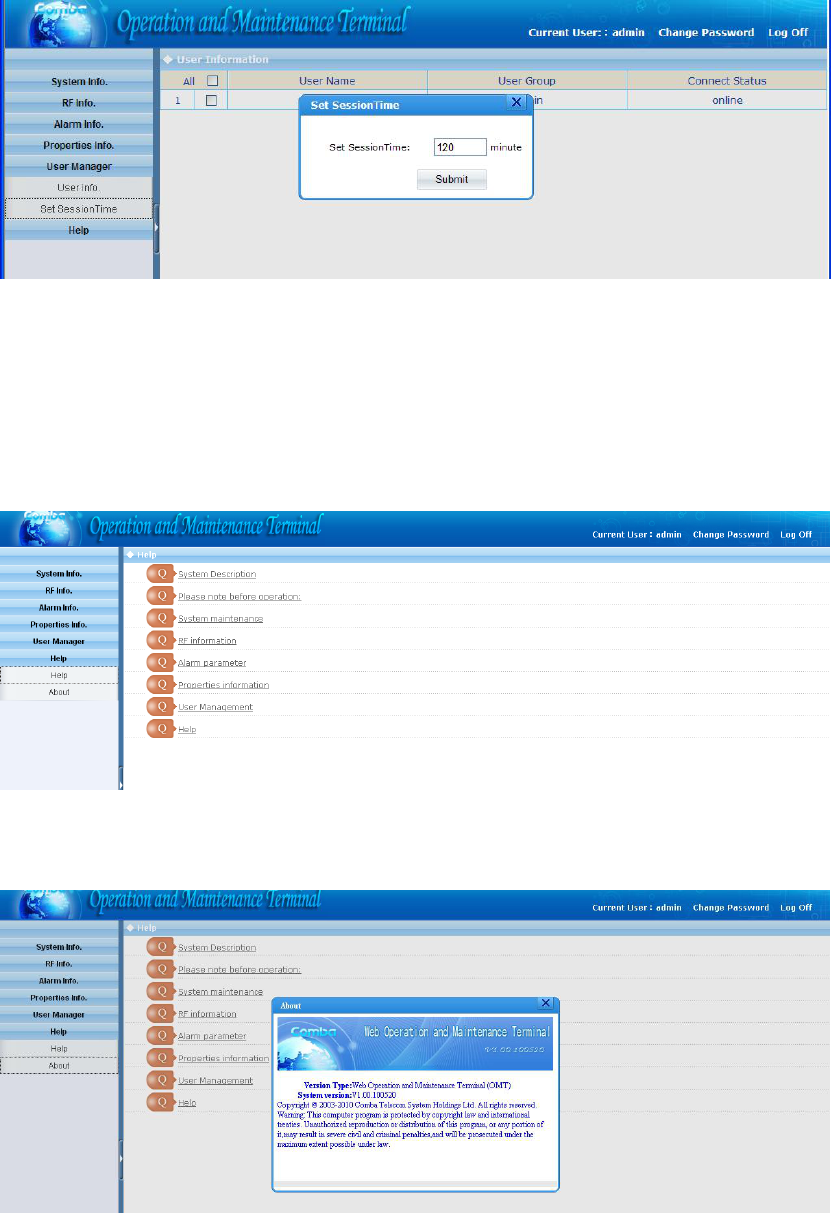
USER MANUAL FOR RA-5700
RA-5700 QI
Copyright - refer to title page
Page 47
ENU Status : 1-1-2
Set Session Time
Figure 43: Set Session Time
[Set Session Time] is to set the automatic log-off time.
4.4.8 HELP
Help
Figure 44: Help
About
Figure 45: About
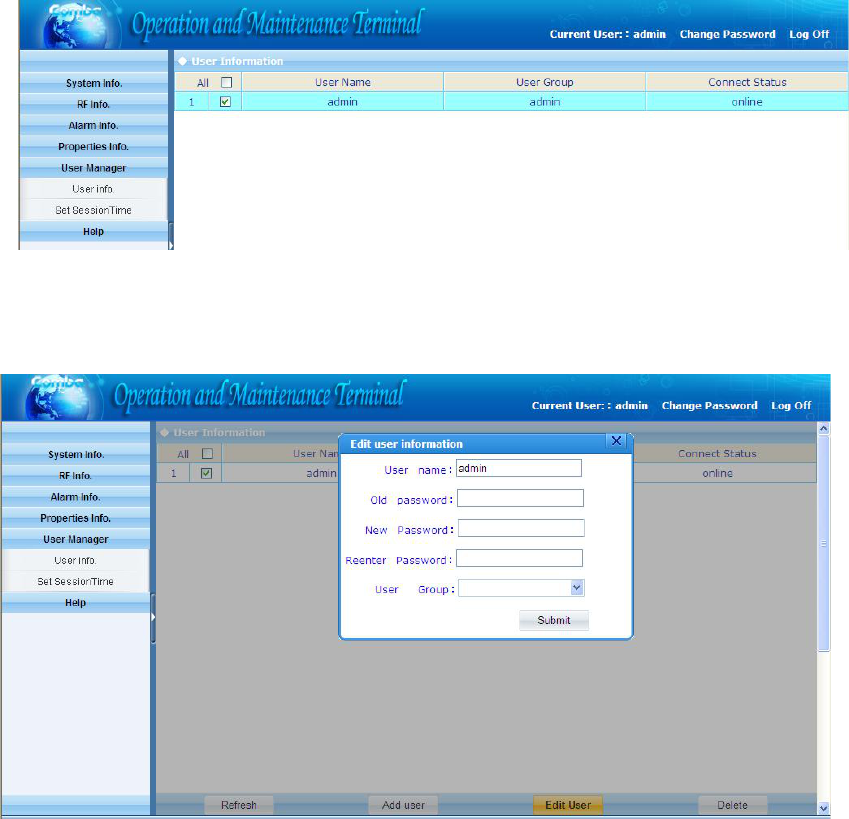
USER MANUAL FOR RA-5700
RA-5700 QI
Copyright - refer to title page
Page 48
ENU Status : 1-1-2
4.4.9 CHANGE PASSWORD
Click [User Info.]-> select the wanted user as illustrated.
Figure 46: Password Configuration
Sumit the request of <Edit User> buttom in the bottom, a pop-up window might shown out to indicate an
on-going step.
Figure 47: Change Password
End of section

USER MANUAL FOR RA-5700
RA-5700 QI
Copyright - refer to title page
Page 49
ENU Status : 1-1-2
5 TROUBLESHOOTING
Following installation and commissioning, occasional operation tasks to handle alarms may be required:
Alarm condition
Diagnosis
DL Input Power Overload alarm
Eliminate alarm by correct setting of DL Input Power Overload threshold. If the setting is OK but alarm
persists, the DL input power might be higher than the threshold. Increase the attenuator to reduce the
input power or replace the coupler with a new one of high coupling effect. Check the cable connection of
the DT port to the BTS.
External Alarm
Check to make sure if the external device connected is working normally
Li-ion Battery Fault Alarm
Replace the faulty modules and return it to the factory for repair.
Over- Temperature alarm
Eliminate alarm by correct setting of temperature threshold, including normal and severe. If alarm can not
be cleared, apply climatic protection to the equipment.
Optical TX Alarm
The optical TX part of Optical TX/RX Module is faulty. Check and replace the faulty module and return it to
the factory for repair.
Optical RX Alarm
The optical power at the RX port of the Optical TX/RX Module is lower than the minimum requirement,
which is resulted by the faulty of the optical TX part of Optical TX/RX Module or damaged optical fiber link.
If so, replace the optical TX module. If not, check the working status of the optical fiber to eliminate the
alarm.
Alarm condition
Diagnosis
AC Power Failure Alarm/ DC
Power Fault Alarm
Check AC power cable and verify AC mains supply is normal.
During Power Fault alarm, DC power supply has no output. Check if
DC output power is overloaded or short-circuited. The PSU could be
faulty.
Li-ion Battery Fault Alarm
Check the connection between battery and power supply cable. Or
replace the faulty modules and return it to the factory for repair.
External Alarm
Check to make sure if the external device connected is working
normally
Over- Temperature alarm
Eliminate alarm by correct setting of temperature threshold, if alarm
can not be cleared, apply climatic protection to the system under
severe environment.
Door Open Alarm
Check whether the enclosure door is closed.
ALC Alarm
Check to see if PA alarm or DL input power overload alarm occur
via OMT/OMC. If so, adjust DL input power or replace a new PA.
Shutdown Alarm
Alarm occurs when automatically shut off the system. Turn on the
system and check if the DL output power overload alarm persists,
adjust the DL output power overload threshold to a proper value.
Manual Shutdown Alarm
Alarm occurs when manually shut off the system. Turn on the
system to eliminate the alarm.
Module Software Alarm
Alarm occurs when the module software failed. Reboot the system
or update the software.
Optical TX Alarm
The optical power at the TX port of the Optical TX/RX Module is
lower than the minimum requirement, which is resulted by the faulty
of the optical TX part of Optical TX/RX Module or damaged optical
fiber link. If so, replace the optical TX/RX module. If not, check the
working status of the optical fiber to eliminate the alarm.
Optical RX Alarm
The optical RX part of Optical TX/RX Module is faulty. Check and
replace the faulty module and return it to the factory for repair.
UL LNA, DL PA alarms
Check power and signal connections of respective modules. If the
power and signal wire connections are OK, then the respective
modules may be faulty. Replace the faulty modules and return it to
the factory for repair.
Master/Slave Unit Link Alarm
The communication between the MU and RU is abnormal. Check
the working status of Optical TX/RX Module and FSK.
DL Input Power Overload
Alarm
Eliminate alarm by correct setting of DL Input Power Overload
threshold. If the setting is OK but alarm persists, the DL input power
might be higher than the threshold. Decrease the gain to reduce the
input power or replace the coupler with a new one of high coupling
effect.
DL Output Power Overload
Alarm
Eliminate alarm by correct setting of DL Output Power Overload
threshold. If the setting is OK but alarm persists, the DL output
power might be higher than the threshold. Decrease the gain to
reduce the output power.
DL Output Power Low Alarm
Eliminate alarm by correct setting of DL Output Power Low

USER MANUAL FOR RA-5700
RA-5700 QI
Copyright - refer to title page
Page 50
ENU Status : 1-1-2
threshold. If the setting is OK but alarm persists, the DL output
power might be lower than the threshold. Increase the gain to high
up the output power.
External Alarm
Check to make sure if the external device connected is working
normally
Table 14: Alarms Diagnosis
End of Section
6 MAINTENANCE
The RA-5700 system is designed for trouble-free operation and generally does not need maintenance.
Maintenance activities should only be carried out by trained personnel.
The equipment operation status can be observed remotely through OMT/OMC.
Periodic inspection of the system is recommended. The recommended tasks include:
Measurement of the return loss of the feeder system.
Ensure the stable connection of cables, power cords and facilities located indoor.
Inspect and record operation status and parameters, such as receive signal level, DL output power of
the system, from OMC or OMT.
Check the PSU voltage of MU.
Verify that the actual coverage effects have not degraded.
Check the working status of optical TX/RX power.
Check the controlling and monitoring function.
Verify lightning and grounding protection is in good condition.
End of Section
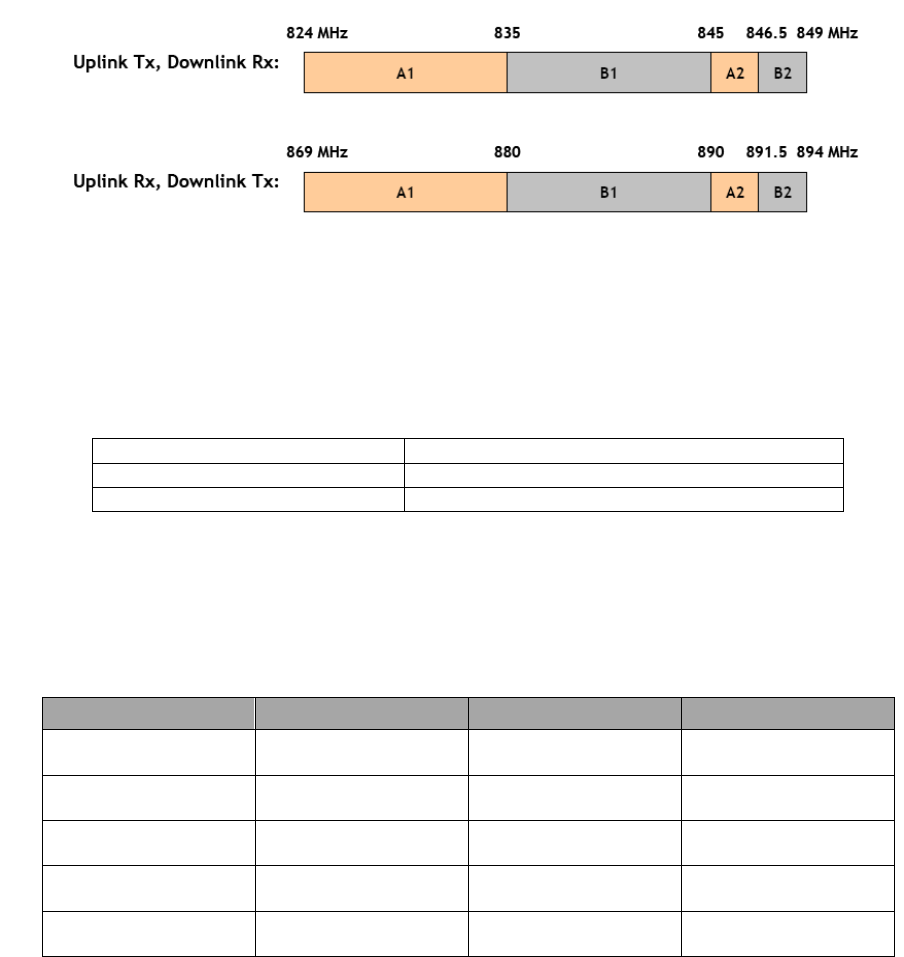
USER MANUAL FOR RA-5700
RA-5700 QI
Copyright - refer to title page
Page 51
ENU Status : 1-1-2
7 APPENDICES
7.1 APPENDIX A: BAND SELECTIVE UNIT USER MANUAL
7.1.1 BS-8132 BSU (BAND SELECTIVE UNIT)
1) Working frequency:
1) Applications:
1> A1+A2
2> B1+B2
3> A band + B band
To realize the channel function, please refer to the following table;
Channel 1
Channel 1/2 ON
A2+B2 (1.5MHz~4MHz set available)
Channel 1 ON, Channel 2 OFF
A band + B band (total 25MHz)
NOTE that Channel 2 can only realize A1 + B1 (1.5MHz~21MHz set avilable) bandwidth.
2) Set channel No. as center channel number
Bandwidth= (Upper edge No. – Lower edge No.) x 30KHz + 1.23MHz
3) CDMA850 channel No.
Working Band
Channel
DL Channel No.
UL Channel No.
A1
2
1011
314
B1
2
354
647
A2
1
687
697
B2
1
737
779
A band + B band
1
1011
779
Table 15: Bandwidth and Channel No.
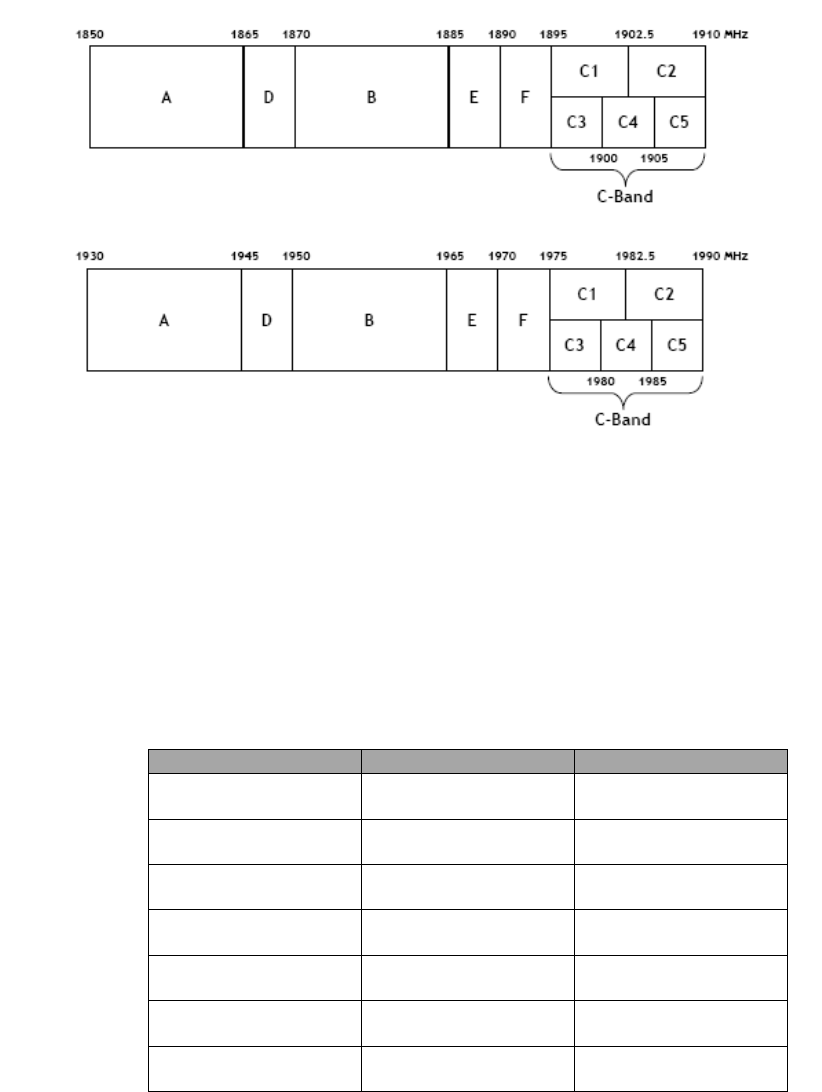
USER MANUAL FOR RA-5700
RA-5700 QI
Copyright - refer to title page
Page 52
ENU Status : 1-1-2
7.1.2 BS-1933 BSU
1) Working frequency:
PCS Band (1850-1990 MHz): Up to 20 MHz of spectrum in no more than 3 non-contiguous PCS sub-
bands of 5, 10 or 15 MHz each based on VZW‟s PCS licenses.
2) Applications:
Channel 1~3 is 5MHz~15MHz bandwidth settable while 60MHz can be set and which can not be
iterant set.
The minimum interval between Lower edge No. and Upper edge No. is 75, while the maximum is 275.
3) Set channel No. as center channel number
Bandwidth= (Upper edge No. – Lower edge No.) x 50KHz + 1.25MHz
4) CDMA1900 channel No.
Working Band
DL Channel No.
UL Channel No.
A
13
288
D
313
388
B
413
688
E
713
788
F
813
888
C
913
1186
C1
913
1050
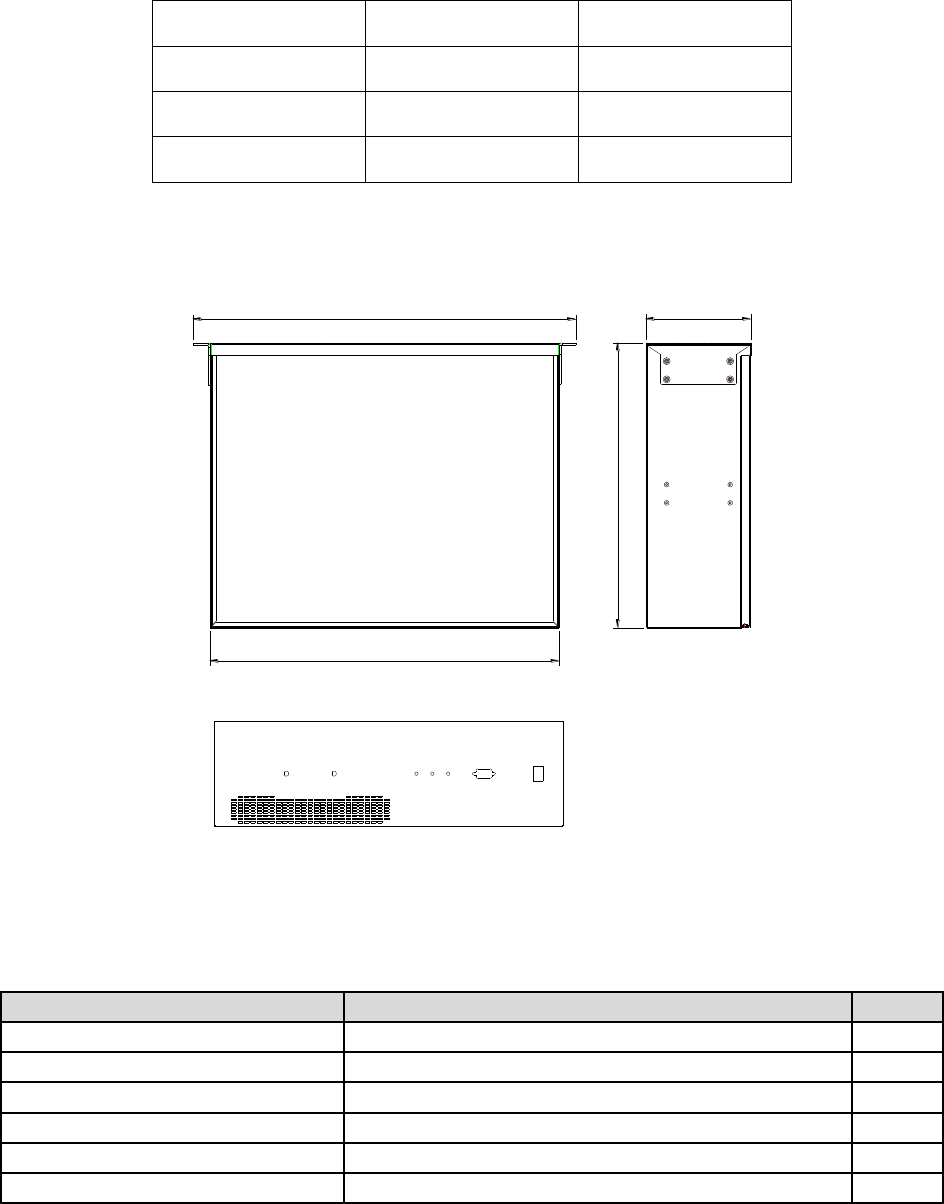
USER MANUAL FOR RA-5700
RA-5700 QI
Copyright - refer to title page
Page 53
ENU Status : 1-1-2
C2
1063
1188
C3
913
988
C4
1013
1088
C5
1113
1188
7.1.3 BS-8132&BS-1933 BSU LAYOUT
5.2"
17.2"
17.3"
19"
ALM PWR
RUN RS-232
DT MT
Figure 48: BSU Layout
7.1.4 BS-8132&BS-1933 KOP
For the system, the following are shipped.
Product Identifier
Description
Quantity
Power Supply Cable
1
Field Commissioning Cable
R-9122C/R-9122AC
1
RF Jumper
1
N to SMA Connector
N female to SMA male
1
Feeder Cable
N male to N male; customized length accordingly
1
Philips Pan Head Screw
GB/T818, M5x10
4
Table 16: BS-1933 KOP
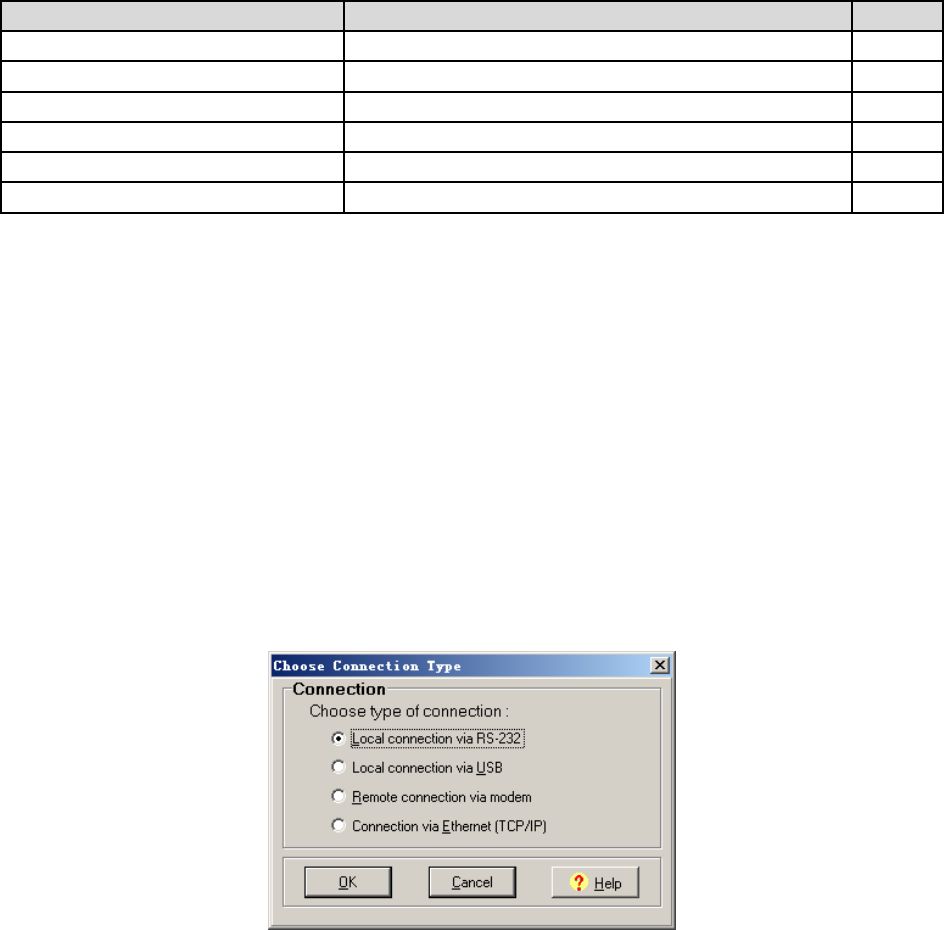
USER MANUAL FOR RA-5700
RA-5700 QI
Copyright - refer to title page
Page 54
ENU Status : 1-1-2
Product Identifier
Description
Quantity
Power Supply Cable
1
Field Commissioning Cable
R-9122C/R-9122AC
1
RF Jumper
1
N to SMA Connector
N female to SMA male
1
Feeder Cable
N male to N male; customized length accordingly
1
Philips Pan Head Screw
GB/T818, M5x10
4
Table 17: BS-8132 KOP
7.1.5 BSU OMT
7.1.5.1 LOCAL TO OMT
After installing OMT software on the PC, connection to the equipment can be done locally.
Double click the OMT explorer icon, the OMT Explorer main screen window will appear.
7.1.5.2 LOCAL CONNECTION TO OMT
After database configuration is done successfully, the following window will pop up and select [Local
connection via RS-232] for local connection.
Figure 49: Connection Type
Select the desired communication port and click “OK”, it will enter into the main window of OMT.
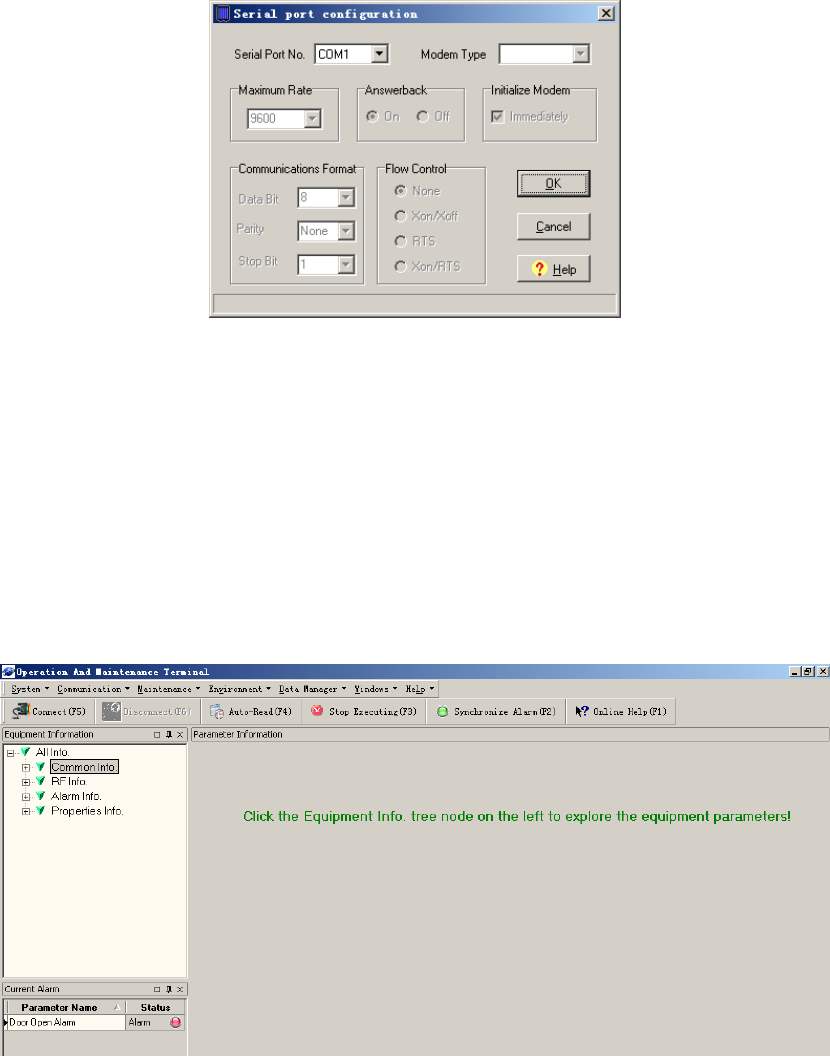
USER MANUAL FOR RA-5700
RA-5700 QI
Copyright - refer to title page
Page 55
ENU Status : 1-1-2
Figure 50: Serial Port Configuration
7.1.5.3 OMT CONFIGURATION
After entering the OMT main screen, click the “Connect” button on the toolbar, to connect the equipment
to the OMT. Successful connection will be indicated by a message “Online Ok” and equipment
parameters can be read and/or set.
Users can configure the parameters, and then offset the parameters according to desired coverage level
and interference to other BTS signals.
OMT parameters include: Common Information, RF Information, Alarm Information, and Properties
Information.
Figure 51: Main Window
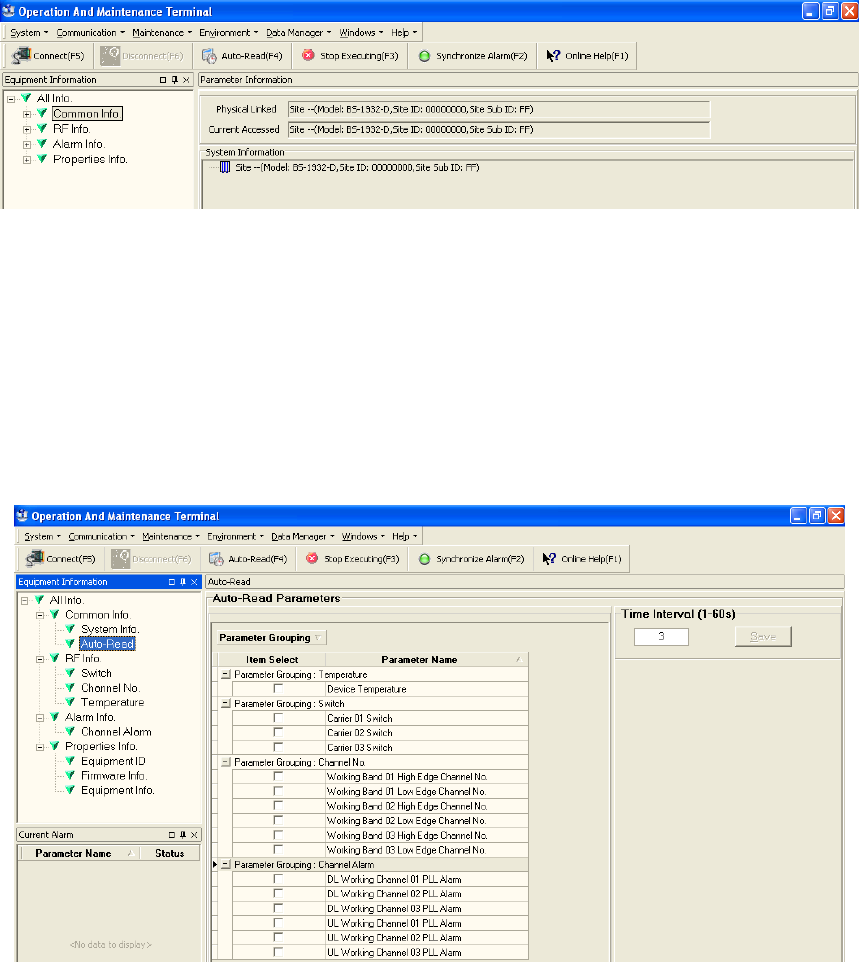
USER MANUAL FOR RA-5700
RA-5700 QI
Copyright - refer to title page
Page 56
ENU Status : 1-1-2
7.1.6 BS-1933 OMT
7.1.6.1 Common Information
System Information
Click on [System Info.] within Equipment Information, system information will be displayed in the right
interface of the OMT screen.
Figure 52: System Information
Auto-Read
Customer can set which parameters to be read automatically at a particular time interval.
Click on the [Auto-Read] node in the right interface the parameters will be displayed in the right interface.
Select the desired parameters and click [Save] button. Input a number in the time interval field and click
the adjacent [Save] button to admit the setting.
Example: If the time interval is 3 seconds, then the selected alarm parameters will be read automatically
every 3-second.
Figure 53: Auto-Read
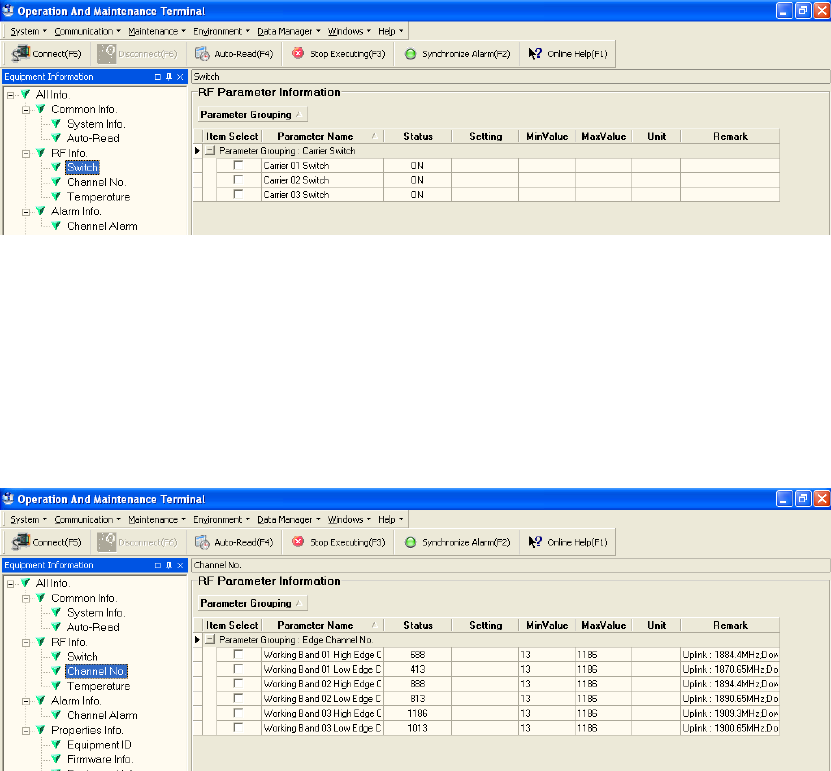
USER MANUAL FOR RA-5700
RA-5700 QI
Copyright - refer to title page
Page 57
ENU Status : 1-1-2
7.1.6.2 RF Parameter
It is recommended to configure the following RF parameters for the first installation.
SWITCH
Switch is to enable/disable power for internal modules. When user checks and sets non-RF parameters,
such as checking physical antenna connection, switching off will disable equipment power temporarily to
protect PA in operation.
Figure 54: Switch
Config:
Select the required state in setting columns of RF information window for RF switch, then press [Enter] or
[Config] button to finish the configuration operation.
CHANNEL NO.
Channel No. includes Low Edge Channel No. and High Edge Channel No. The value in [MaxValue]
column is the upper limit of the range, while the value in [MinValue] column is the lower limit of the range.
Figure 55: Channel NO.
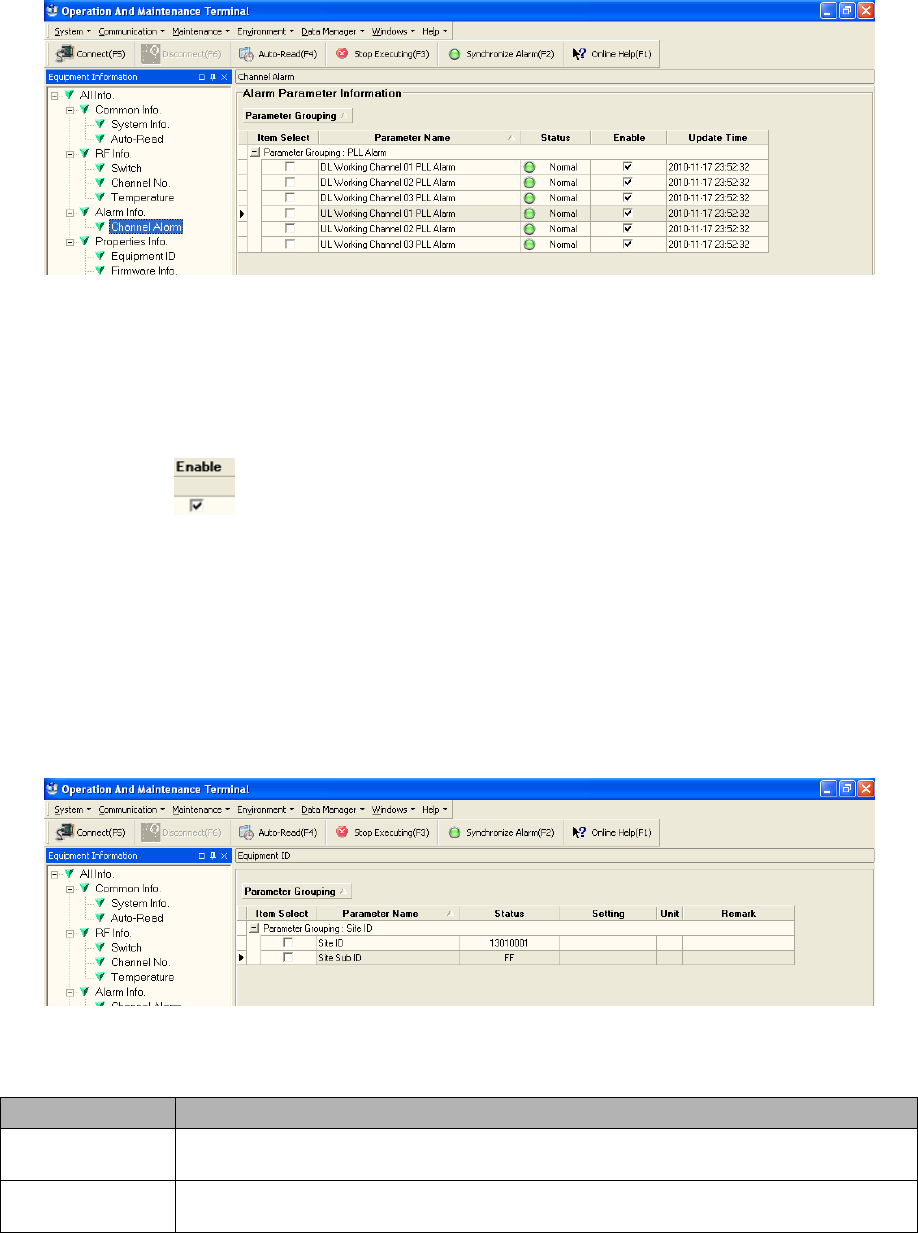
USER MANUAL FOR RA-5700
RA-5700 QI
Copyright - refer to title page
Page 58
ENU Status : 1-1-2
7.1.6.3 Alarm Information
Figure 56: Channel Alarm
Config:
Tick the check box of [Item select] and [Enable] of the desired parameters and click [config] button to
finish configuration operation.
Notice: [Enable] box is to enable the alarm monitoring for system. Only if users enable the alarm by
ticking the [Enable] box, the alarms can be monitored by the OMT/OMC.
7.1.6.4 Properties Information
EQUIPMENT ID
Equipment ID is to be configured after local commission has been completed, which includes Site ID, and
Site Sub ID.
Figure 57: Equipment ID
See the table below for configuration details of each parameter.
Item
Description
Site ID
Site ID is the unique equipment identification. It is a hexadecimal string of eight
characters in the range of [00000000~FFFFFFFF]. e.g. 00000000
Site Sub ID
Site Sub ID is used for Master-Slave System. It is the unique identification of each
Master/ Slave Unit and is a hexadecimal string of two characters in the range of
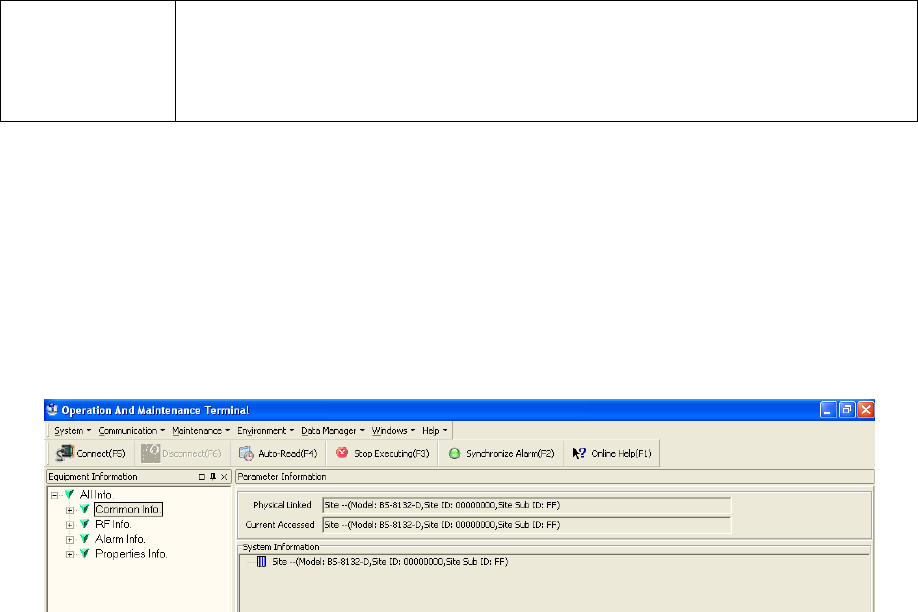
USER MANUAL FOR RA-5700
RA-5700 QI
Copyright - refer to title page
Page 59
ENU Status : 1-1-2
[00~FF].
For the system located with single equipment, the Site Sub ID should be FF.
For Master-Slave system, the Site Sub ID for Master Unit is 00, and the Site Sub
ID for each Slave Unit is represented in the range of [01~FE] in ascending order.
e.g. Master Site ID: 00, Slave Site ID: 01
7.1.7 BS-8132 OMT
7.1.7.1 Common Information
System Information
Click on [System Info.] within Equipment Information, system information will be displayed in the right
interface of the OMT screen.
Figure 58: System Information
Auto-Read
Customer can set which parameters to be read automatically at a particular time interval.
Click on the [Auto-Read] node in the right interface the parameters will be displayed in the right interface.
Select the desired parameters and click [Save] button. Input a number in the time interval field and click
the adjacent [Save] button to admit the setting.
Example: If the time interval is 3 seconds, then the selected alarm parameters will be read automatically
every 3-second.
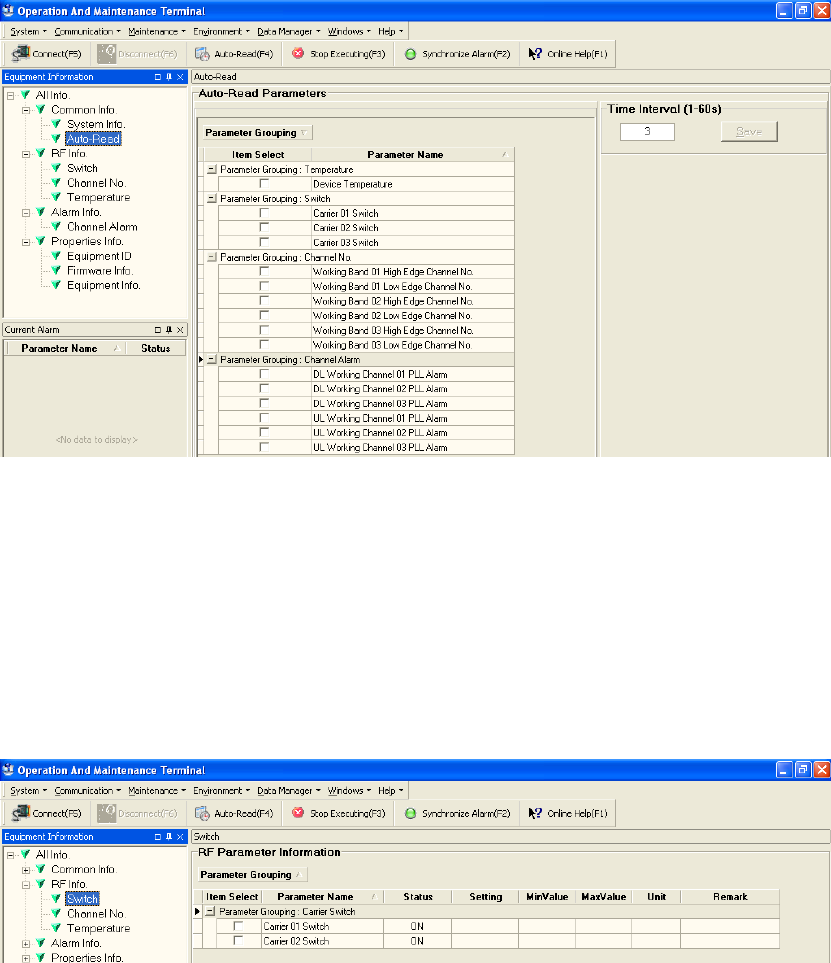
USER MANUAL FOR RA-5700
RA-5700 QI
Copyright - refer to title page
Page 60
ENU Status : 1-1-2
Figure 59: Auto-Read
7.1.7.2 RF Parameter
It is recommended to configure the following RF parameters for the first installation.
SWITCH
Switch is to enable/disable power for internal modules. When user checks and sets non-RF parameters,
such as checking physical antenna connection, switching off will disable equipment power temporarily to
protect PA in operation.
Figure 60: Switch
Config:
Select the required state in setting columns of RF information window for RF switch, then press [Enter] or
[Config] button to finish the configuration operation.
CHANNEL NO.
Channel No. includes Low Edge Channel No. and High Edge Channel No. The value in [MaxValue]
column is the upper limit of the range, while the value in [MinValue] column is the lower limit of the range.
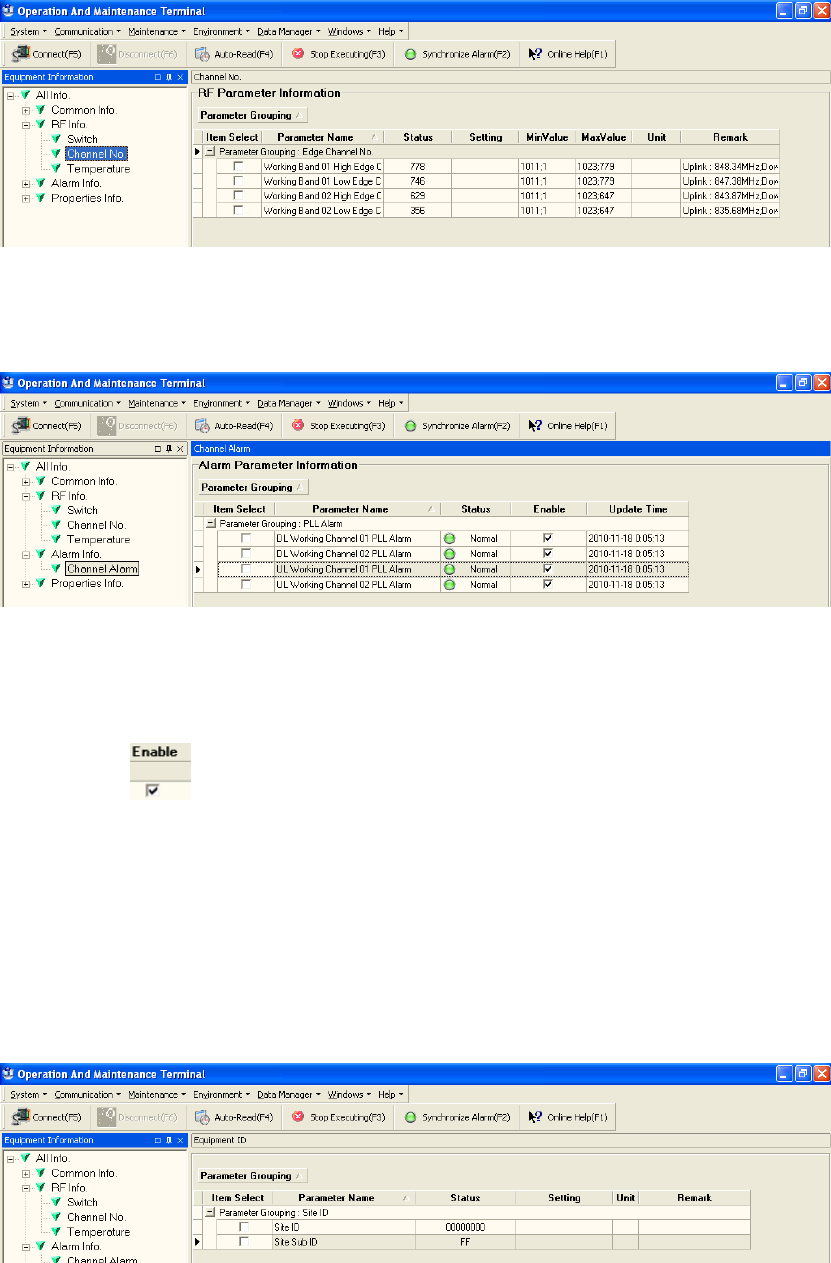
USER MANUAL FOR RA-5700
RA-5700 QI
Copyright - refer to title page
Page 61
ENU Status : 1-1-2
Figure 61: Channel NO.
7.1.7.3 Alarm Information
Figure 62:Channel Alarm
Config:
Tick the check box of [Item select] and [Enable] of the desired parameters and click [config] button to
finish configuration operation.
Notice: [Enable] box is to enable the alarm monitoring for system. Only if users enable the alarm by
ticking the [Enable] box, the alarms can be monitored by the OMT/OMC.
7.1.7.4 Properties Information
EQUIPMENT ID
Equipment ID is to be configured after local commission has been completed, which includes Site ID, and
Site Sub ID.
Figure 63: Equipment ID
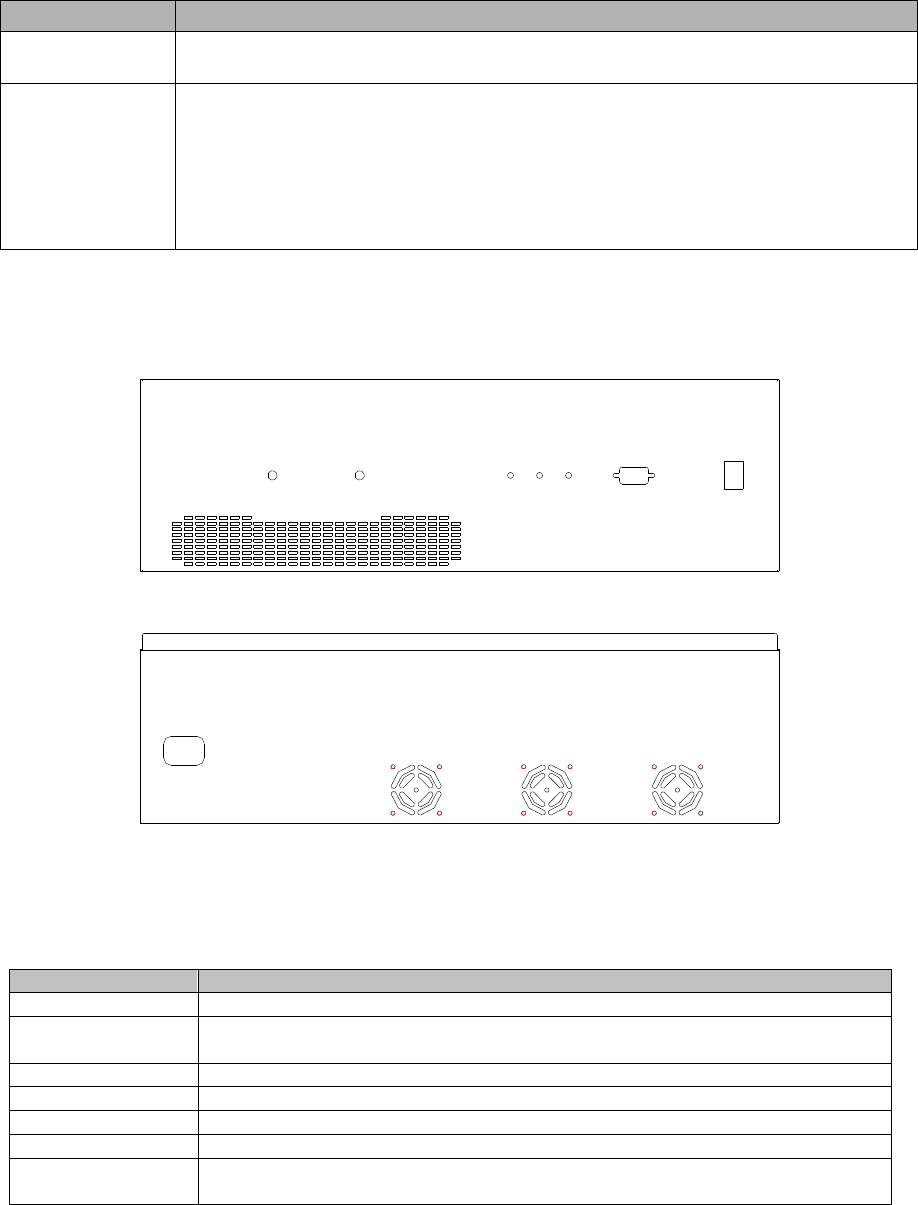
USER MANUAL FOR RA-5700
RA-5700 QI
Copyright - refer to title page
Page 62
ENU Status : 1-1-2
See the table below for configuration details of each parameter.
Item
Description
Site ID
Site ID is the unique equipment identification. It is a hexadecimal string of eight
characters in the range of [00000000~FFFFFFFF]. e.g. 00000000
Site Sub ID
Site Sub ID is used for Master-Slave System. It is the unique identification of each
Master/ Slave Unit and is a hexadecimal string of two characters in the range of
[00~FF].
For the system located with single equipment, the Site Sub ID should be FF.
For Master-Slave system, the Site Sub ID for Master Unit is 00, and the Site Sub
ID for each Slave Unit is represented in the range of [01~FE] in ascending order.
e.g. Master Site ID: 00, Slave Site ID: 01
7.1.8 BS-8132&BS-1933 BSU CONNECTORS
DT
Front Panel
MT RUN ALM PWR RS232
AC 100V-240V
50Hz/60Hz
Rear Panel
Figure 64: BSU Connectors
Identifier
Functional Description
DT
SMA connector, connects with BTS
MT
SMA connector, BS-8132_MT connects with RA-5700D_850MHz connector
while BS-1933_MT connects with RA-5700D_1900MHz connector
RUN
Operation indicator
ALM
Alarm indicator
PWR
Power supply indicator
RS232
DB9 connector, connects to PC via engineering OMT.
AC 100-240V
50Hz~50Hz
Power supply
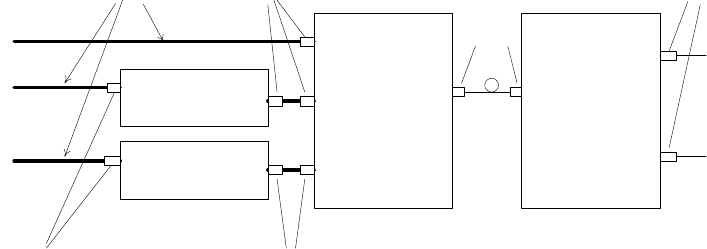
USER MANUAL FOR RA-5700
RA-5700 QI
Copyright - refer to title page
Page 63
ENU Status : 1-1-2
Signal source
BS8132 Band
Selective Unit
BS1933 Band
Selective Unit
RA5700
Triband
Master Unit
850Mhz
1900Mhz
700Mhz
RA5700
Triband
Remote Unit
700Mhz Output
850Mhz+1900Mhz
Output
Coaxial cable
FC/APC
Female N
connector
SMA connector
SMA connector
SMA connector
Figure 65: BSU Connection Overview
7.2 APPENDIX B: TOOLS FOR INSTALLATION AND MAINTENANCE
The following are the recommended list of tools new installation and routine maintenance:
Electronic drill
Allen Key
Adjustable spanner (Assorted size: 0.31~0.79 inch)
Philips Screwdriver
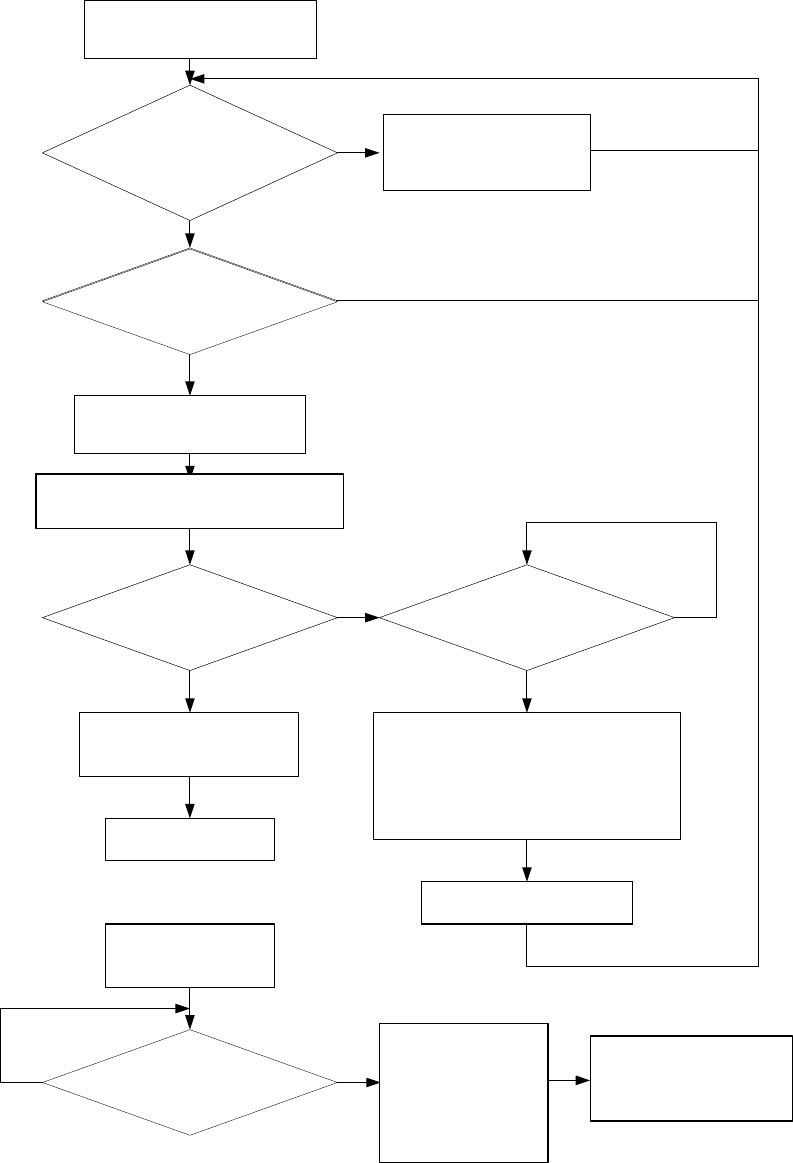
USER MANUAL FOR RA-5700
RA-5700 QI
Copyright - refer to title page
Page 64
ENU Status : 1-1-2
7.3 APPENDIX C: OVERDRIVE PROTECTION PROCEDURE
DL output power level >
shutdown protection power
threshold
Y
threshold persistent time > 5s
100% (time can set)
Y
Automatic shutdown
protection ON (RF switch
OFF)
Shutdown protection time >
15mins (time:10mins~24hrs)
Y
Y
Restart RF signal switch
Threshold overtime
Shutdown protection time
Clean shutdown protection
count
shutdown protection time
duration > 3 times (times: 1~255
available)
Y
Shutdown protection
alarm: permanent
shutdown
N
N
N
Shutdown protection count + 1
Set timer of shutdown protection time
End
Threshold overtime
Clean shutdown protection
counter
N
延延延延延延延延延延延
System initiation
RF signal “ON” manually
Reboot automatic
shutdown protection
procedure
NYThreshold overtime
Shutdown protection
time
Clean shutdown
protection count
NOTE: 1. Independent control for each channel (850/1900/700)
2. Activate RF signal switch manually when the system is under permanent shutdown.
3. Overdrive protection procedures will be activated after manually turning on RF
Overdrive Protection
Procedures
DL output power level >
shutdown threshold
Over threshold duration reaches
5 secs(Duration configurable)
and all detections over threshold
No overdrive detected
when detection is over.
Shutdown counter clear to
null
Overdrive protection
activated, RF switch off.
Overdrive protection counter + 1
Start timer of overdrive protection
Overdrive protection counter > 3
(Range: 1~255)
Overdrive protection duration >
15mins ( Range:10mins~24hrs)
Irreversible RF swtich
turned off, overdrive
protection alarm is triggered
Turn on RF switch
Reset over threshold duration timer
Reset overdrive protection duration timer
Reset overdrive protection counter
Extra time until RF
stablized
Reset over threshold
duration timer
Reset overdrive
protection duration
timer
Reset overdrive
protection counter
Reactivate overdrive
Protection Procedures
USER MANUAL FOR RA-5700
RA-5700 QI
Copyright - refer to title page
Page 65
ENU Status : 1-1-2
7.4 APPENDIX D: SERVICING POLICY AND RETURN OF EQUIPMENT
The repair of individual units and modules of this equipment is not considered practicable without factory
facilities. It is, therefore, the policy of Comba whereby faulty units or modules are returned to the local
agent for repair.
To enable an efficient, prompt after sales service to be provided for the diagnosis, repair and return of any
faulty equipment, please comply with the following requirements.
Items to be sent for repair should be packaged so as to provide both electrostatic and physical protection
and a Repair Material Authorization (RMA) should be completed giving the required information. A sample
RMA form is provided in Appendix.
This request must be included with the item for repair. Items for repair should be sent to the nearest
Comba office:
COMBA TELECOM LTD.
Hong Kong Office
Address: 611 East Wing, No. 8 Science Park West Avenue, Hong Kong Science Park, Tai Po, Hong
Kong.
Tel: +852 2636 6861 Fax: +852 2637 0966
Singapore Office
Address: No. 1 Kaki Bukit View, #02-10 Techview, Singapore 415941
Tel: + 65 6345 4908 Fax: + 65 6345 1186
Thailand Office
Address: 240/34 Ayothaya Tower 18th Floor, Ratchadapisek Road, Huaykwang, Bangkok 10320, Thailand
Tel: +66 2274 1618-9 Fax: +66 2274 1620
India Office
Address: Suite No. 2, E-172, TSH House, Greater Kailash – I, New Delhi – 110 048, India
Tel: + 91 11 4173 9997 / 8 Fax: + 91 11 4173 9996
Sweden Office
Address: Gustavslundsvagen 147, S- 167 51 Bromma, Stockholm, Sweden
Tel: +46 8 25 38 70 Fax: +46 8 25 38 71
Brazil Office
Address: Avenida Engenheiro Luiz Carlos Berrini 1297, cj 122, 04571-090 Brooklin Novo, São Paulo,
Brazil
Tel: +55 11 35093700 Fax: +55 11 35093720
Dubai Office
Address: P.O. Box 450583, DUBAI, U.A.E.
Tel: +971 0 4 433 5320 Fax: +971 0 4 422 6774
US Office
Address: Comba Telecom Inc. 2390 Bering Drive, San Jose, CA 95131, USA
Tel: +1 408 526 0180 Fax: +1 408 526 0181
China Office
Address: No.10, Shenzhou Road, Guangzhou Science City, Guangzhou, China
Tel: + 86 20 2839 0000 Fax: + 86 20 2839 0136
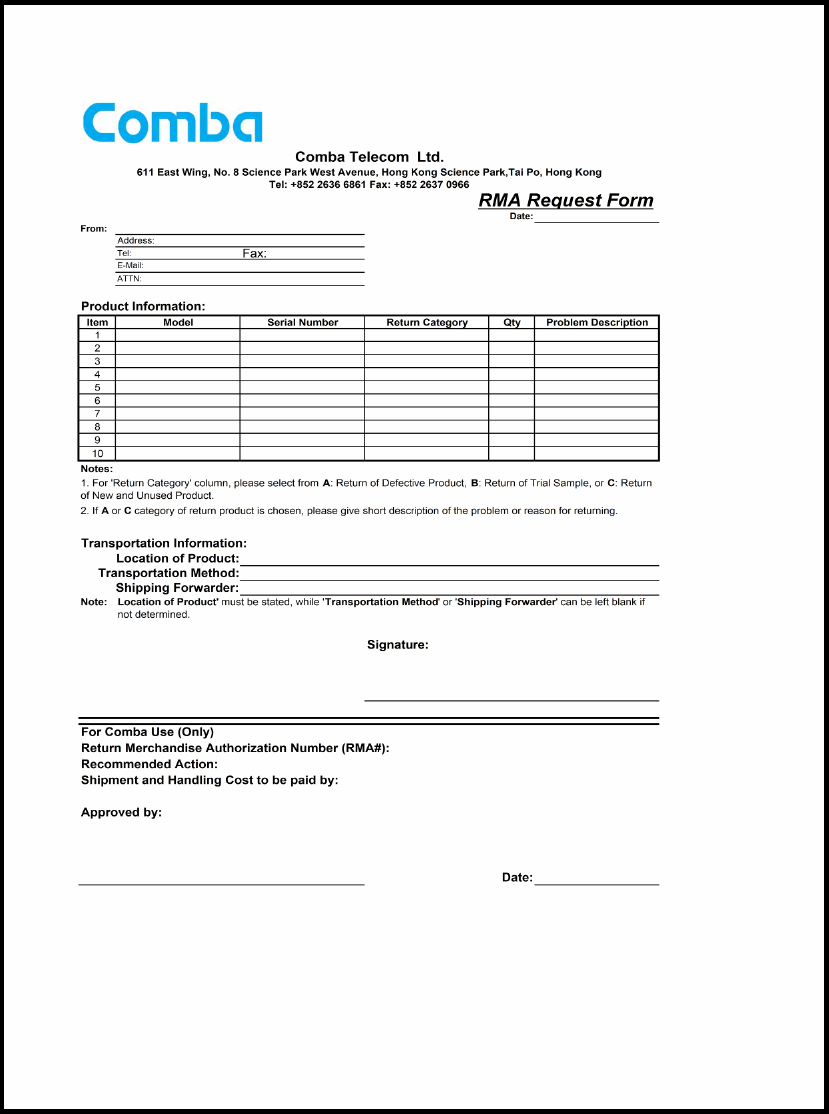
USER MANUAL FOR RA-5700
RA-5700 QI
Copyright - refer to title page
Page 66
ENU Status : 1-1-2
7.5 APPENDIX E: RMA (RETURN MATERIAL AUTHORIZATION) FORM
End of Section
End of Document